
Jordan Yacht Brokerage

We Never Underestimate Your Dreams
Sailboat rudder types – full, spade, skeg, outboard.
The four rudder types are: full, spade, skeg, and outboard. This article discusses the advantages and disadvantages of each.

Full The full or full keel rudder lies at the aft end of a full length keel. The keel-rudder streches along the entire length of the bottom of the hull. The full rudder is safe and nearly invulnerable to damage. The leading edge of the keel protects the rudder from flotsam. The full rudder is quintessential of offshore cruisers like Wetsails and Cabo Ricos. Even grounding may not cause damage. The boat will sit comfortable on its side until the tide returns and floats the boat back up.
Spade The spade rudder lies at the aft separate from the keel. A spade rudder is easy to turn because the water rushes both against its fore and aft edges – great for using a tiller. A spade rudder is also fast as the wet area less than a full keel. The boat racing along with less resistance. Spade and partial spades are becoming the most popular rudder type. The Hylas 70 has a partial spade rudder as well as early 54’s.

Skeg A skeg rudder is more modern in performance and safety. It is the most popular and common type of rudder on production boats these days. The rudder is fast and looks like a spade keel. Except, the skeg rudder has a fake keel which extends from the hulls aft and protects the fore edge. Most Hylas yachts have skeg rudders.
Outboard Outboard rudders are seen on smaller boats. They simply hang over the stern of the boat. For example, racing prams use outboard rudders. They are easy to fasion as emergency rudders. You can make one out of a handlerail and cabin door.
Conclusion A rudder is either full, spade, skeg, or outboard. Each type has its benefits. The most important part is make sure she is in good condition and have a spare.
4 Replies to “Sailboat Rudder Types – Full, Spade, Skeg, Outboard”
Ahoy Mateys, it’s Fox Axel the Pirate. I’ve got a swashbuckling yarn to tell ye. Me was drifting along way out at sea. Me had lost me steering while pillaging a friendly ship. The knaves canon knocked me rudder off. Me had nought to to turn to. The authorities would hang me, the villainous lot. But, me was getting desperate out of grub and rum, nothing to sage me drunken pirate ways. I had lost me last vestige of sanity.
Finally, me saw in the distance a giant whaler coming. The big ship sailed straight at me. “Ahoy mateys!” me spake. The freighter came near, too near. Shiver me timbers. The goulish crew must be drunk out of thee minds. Me could not steer away. She rammed straight slicing me ship in twain. Down to Davy Jones’ locker we went. Take care with ye rudders mateys – the Pirate of Monkey Isle.
Ok ye swabs ave a told me to finish me story. Ere dis da rest. As the freighter tore away leaving me to perish in the sea. I climbed on a board of driftwood from me sinkin’ ship. I passed out adrift, alone. When I came to, I found meself shipwrecked on a deserted island. I stumbled around and ran into, who of all? Big Red, me pirate enemy! Aye, I’m shipping as mate with his goulish fleet until I can betray and kill him. Aye, hope Big Red ain’t reading dis here blog. Black Fox the Pirate.
I am ye swab. I am too sharp for some ere fool like ye. I ain’t gots no book learning, but me hast carniving ways from many years below the mast. Iffen ye be trying to betray me, I am a gonna get ye.
Thank you for sharing this article.It’s quite easy to understand the difference.
Leave a Reply
Your email address will not be published. Required fields are marked *
Save my name, email, and website in this browser for the next time I comment.
- Paddle Board

What Is a Sailboat Rudder? An Overview of Its Function and Design
Sailboats have been used for thousands of years to traverse water. They have undergone many changes and improvements over the years, and one of the essential components of a sailboat is the rudder.
Quick Facts
| Topic | Description |
|---|---|
| Rudder | It is essential for steering and balancing the boat. |
| The main components are the stock, the blade, pintles, and gudgeons. | |
| Transom-mounted, skeg-mounted, keel-mounted, and spade rudders. | |
| Wood, aluminum alloy, stainless steel, and fiberglass-reinforced plastic. | |
| Influenced by the boat’s size, weight, speed, water and wind conditions, and the sailor’s skill level. | |
| Size, shape, placement, hydrodynamic, and aerodynamic factors. | |
| Involves regular inspection for signs of wear and tear, corrosion, loose components, and ensuring smooth operation. | |
| Corrosion, damage to the blade or stock, and loose components. | |
| Necessary when damage is extensive or to upgrade to a newer design for improved performance. |
Understanding the Sailboat Rudder
The rudder is a vital component of a sailboat that plays a crucial role in steering and maneuvering the vessel. The rudder works by changing the direction of the water flow around it, which moves the boat in the opposite direction. Without a rudder, it would be impossible to navigate a sailboat effectively, especially in different water and wind conditions.
Components of a Sailboat Rudder
A sailboat rudder comprises several components, each with a unique function that contributes to the rudder’s overall effectiveness. The stock is the main vertical shaft that connects the rudder blade to the boat’s helm. It is usually made of stainless steel or aluminum alloy and is designed to withstand the forces exerted on the rudder during navigation.
The blade is the flat portion of the rudder that faces the water current and directs the water flow in the opposite direction to steer the boat. The blade is typically made of fiberglass-reinforced plastic or aluminum alloy and is designed to be lightweight and durable. Pintles and gudgeons are the two connections between the rudder and stern that allow for easy installation and removal of the rudder. Pintles are the vertical metal pins that fit into the gudgeons, which are the horizontal metal brackets attached to the boat’s stern.
Different Types of Rudders
There are several types of rudders used in sailboats, each with its advantages and disadvantages. Transom-mounted rudders are the most common type of rudder, and they are mounted on the stern of the boat. Skeg-mounted rudders are attached to a fixed fin called a skeg, which provides additional stability to the rudder.
Keel-mounted rudders are attached to the boat’s keel, which is the central structural element that runs along the bottom of the hull. Spade rudders are free-standing rudders that are not attached to any part of the boat and are commonly used in racing sailboats. The type of rudder used depends on the boat’s size, design, and intended use.
Materials Used in Rudder Construction
Rudders can be made from various materials, each with its advantages and disadvantages. Wooden rudders are the traditional choice and are still used in some sailboats today. However, they are relatively heavy and require regular maintenance to prevent rot and decay.
Aluminum alloy rudders are lightweight and durable, making them an excellent choice for racing sailboats. Stainless steel rudders are also durable but are heavier than aluminum alloy rudders. Fiberglass-reinforced plastic rudders are the most common type of rudder used today, as they are lightweight, durable, and require minimal maintenance.
The sailboat rudder is an essential component that plays a crucial role in steering and maneuvering a sailboat. Understanding the different types of rudders, their components, and the materials used in their construction can help sailors choose the right rudder for their boat and navigate more effectively in different water and wind conditions.

The Function of a Sailboat Rudder
Steering and maneuvering.
The primary function of a sailboat rudder is to steer and maneuver the boat. The rudder’s blade directing the flow of water in a specific direction allows for the steering of the boat as the blade changes direction. Sailors can use the rudder to turn the boat in any direction they choose, allowing them to navigate through narrow channels or around obstacles in the water. It is essential to note that the rudder works in conjunction with the sails to control the boat’s direction and speed.
Balancing the Sailboat
The balance of the sailboat is critical to ensure safe maneuvering, and the rudder plays a crucial role in achieving this. A balanced rudder helps in keeping the boat steady, reducing drag, and preventing unwanted turning. Sailors can adjust the rudder’s angle to keep the boat balanced and on course, especially in rough water conditions. A well-balanced rudder also helps to reduce the risk of capsizing or losing control of the boat .
Rudder Effectiveness in Different Conditions
Rudder effectiveness varies depending on the boat’s size, weight, and water and wind conditions. A larger boat may require a bigger rudder for proper maneuvering, while a smaller boat can work with a smaller rudder. Sailors must also consider the water and wind conditions when choosing the right rudder for their boat. In calm waters, a smaller rudder may be sufficient, but in rough water, a larger rudder may be necessary to maintain control of the boat. Additionally, the rudder’s effectiveness can be affected by the boat’s speed, with higher speeds requiring more significant rudders to maintain control.
It is also important to note that the rudder’s effectiveness can be impacted by external factors such as weeds or debris in the water. These factors can reduce the rudder’s ability to steer the boat and require sailors to make adjustments to maintain control. Additionally, the rudder’s effectiveness can be impacted by the sailor’s skill level, with more experienced sailors able to make more precise adjustments to the rudder to control the boat’s direction and speed.
Design Considerations for Sailboat Rudders
Sailboat rudders are an essential component of a boat’s steering and maneuvering system. A well-designed rudder can make all the difference in a boat’s performance , especially in challenging weather conditions. In this article, we will explore some of the key design considerations for sailboat rudders.
Rudder Size and Shape
The size and shape of a rudder play a crucial role in determining its effectiveness in steering and maneuvering a boat. A larger rudder provides more leverage and maneuverability, allowing the boat to turn more sharply. However, a larger rudder may also produce more drag, which can slow down the boat’s speed.
The shape of the rudder is also important. A well-designed rudder should be streamlined to reduce drag and turbulence. The thickness of the rudder should be carefully considered to ensure that it is strong enough to withstand the forces exerted on it while remaining lightweight.
Rudder Placement and Configuration
The placement of the rudder on the boat can significantly affect its performance. A rudder that is too far forward can cause the boat to become unstable, while a rudder that is too far aft can make it difficult to steer. The location of the rudder must also take into account factors such as the propeller’s placement and the boat’s shape.
The configuration of the rudder can also determine its effectiveness and balance. A single rudder is the most common configuration, but some boats have twin rudders to provide more steering control. The angle of the rudder blade can also be adjusted to optimize its performance.
Hydrodynamic and Aerodynamic Factors
The design of a rudder must take into consideration the hydrodynamic and aerodynamic factors affecting the boat’s performance. Hydrodynamic factors include water flow, pressure, and turbulence, which can significantly affect the rudder’s performance. The shape and placement of the rudder must be carefully designed to minimize these effects.
Aerodynamic factors consider the wind and air resistance’s impact on the boat’s performance. The rudder’s size and shape must be designed to minimize the wind’s effect on the boat while providing sufficient steering control.
The design of a sailboat rudder is a complex process that requires careful consideration of many factors. The size and shape of the rudder, its placement on the boat, and its configuration must be optimized to provide effective steering and maneuverability. By taking into account the hydrodynamic and aerodynamic factors affecting the boat’s performance, a well-designed rudder can significantly improve a sailboat’s overall performance.

Rudder Maintenance and Repair
The rudder is a crucial component of any sailboat, providing steering and control. As such, it’s essential to keep it in good working order through regular maintenance and inspections.
Inspecting Your Rudder
Regular inspection of the rudder is essential to ensure its continued performance and longevity. A thorough inspection includes checking for cracks, wear and tear, and loose components such as hinges, pins, and screws. It’s also important to check the rudder’s alignment and ensure it moves smoothly and without any obstructions.
During your inspection, be sure to check for signs of corrosion, particularly on metal components. Corrosion can weaken the rudder and cause it to fail, so regular cleaning and maintenance are essential to prevent this.
If you notice any issues during your inspection, it’s important to address them promptly. Small cracks or damage can often be repaired, but if the damage is extensive, it may be necessary to replace the rudder entirely.
Common Rudder Issues and Solutions
One common issue with rudders is corrosion, particularly on metal components. Regular cleaning and maintenance help prevent corrosion and ensure the rudder’s longevity. If you do notice signs of corrosion, it’s important to address it promptly to prevent further damage.
Another common issue is damage to the blade or stock. This can be caused by impact with debris or other boats, or simply wear and tear over time. If the damage is minor, it may be possible to repair the rudder. However, if the damage is extensive or compromises the rudder’s structural integrity, it may be necessary to replace it entirely.
Loose components such as hinges, pins, and screws can also cause issues with the rudder. These should be checked regularly and tightened or replaced as needed.
When to Replace or Upgrade Your Rudder
Sailboat rudders can last for many years, but at some point, replacement or upgrade may be necessary. This includes upgrading to a newer design or larger rudder to improve the boat’s performance or replacing a damaged or worn-out rudder that is beyond repair.
If you’re considering upgrading your rudder, it’s important to consult with a professional to ensure that the new rudder is compatible with your boat and will provide the desired performance improvements.
Regular maintenance and inspections are essential to ensure the continued performance and longevity of your sailboat’s rudder. By staying on top of any issues and addressing them promptly, you can ensure that your rudder will continue to provide reliable steering and control for many years to come.

A sailboat’s rudder is a crucial component that helps steer and maneuver the boat safely. The size, shape, placement, and construction materials must all be taken into consideration when designing or replacing a rudder. Regular maintenance and inspection help ensure its continued performance and longevity.
Rudder FAQS
How does a sailboat rudder work.
A sailboat rudder works by changing the direction of the water flow past the boat’s hull, which in turn changes the direction of the boat. The rudder is attached to the stern of the boat and can be turned left or right. When the rudder is turned, it creates a force that pushes the stern in the opposite direction and turns the bow towards the direction the rudder is turned. This is how a rudder steers a boat.
What is a rudder and its purpose?
A rudder is a flat piece, usually made of metal or wood, attached to the stern of a vessel such as a boat or ship. The main purpose of the rudder is to control the direction of the vessel. It does this by deflecting water flow, creating a force that turns the vessel. Without a rudder, steering a vessel would be significantly more challenging.
Can you steer a sailboat without a rudder?
Steering a sailboat without a rudder is challenging but not impossible. Sailors can use the sails and the keel to influence the direction of the boat. By trimming the sails and shifting weight, it’s possible to cause the boat to turn. However, this is a difficult technique that requires a deep understanding of sailing dynamics and is usually considered a last resort if the rudder fails.
What controls the rudder on a sailboat?
The rudder on a sailboat is typically controlled by a steering mechanism, like a tiller or a wheel. The tiller is a lever that is directly connected to the top of the rudder post. Pushing the tiller to one side causes the rudder to turn to the opposite side. On larger boats, a wheel is often used. The wheel is connected to the rudder through a series of cables, pulleys, or hydraulic systems, which turn the rudder as the wheel is turned.
How do you steer a sailboat with a rudder?
To steer a sailboat with a rudder, you use the tiller or wheel. If your sailboat has a tiller, you’ll push it in the opposite direction of where you want to go – pushing the tiller to the right will turn the boat to the left and vice versa. If your sailboat has a wheel, it operates like a car steering wheel – turning it to the right steers the boat to the right and turning it to the left steers the boat to the left.
How do you steer a sailboat against the wind?
Steering a sailboat against the wind, also known as tacking, involves a maneuver where the bow of the boat is turned through the wind. Initially, the sails are let out, and then the boat is steered so that the wind comes from the opposite side. As the boat turns, the sails are rapidly pulled in and filled with wind from the new direction. This maneuver allows the boat to zigzag its way upwind, a technique known as “beating.” It requires skill and understanding of sailing dynamics to execute effectively.

John is an experienced journalist and veteran boater. He heads up the content team at BoatingBeast and aims to share his many years experience of the marine world with our readers.
What to Do If Your Boat Engine Won’t Start? Common Problems & How to Fix Them
How to launch a boat by yourself: complete beginner’s guide, how to surf: complete beginner’s guide to get you started.
Comments are closed.
Type above and press Enter to search. Press Esc to cancel.
- Understanding boat rudders: Navigating the key component for smooth sailing
Navigating a boat requires a complex interplay of various components, and one of the most crucial elements is the rudder. In this comprehensive guide, we will delve into the world of boat rudders, exploring their functionality, importance, and role in steering a ship to smooth sailing.
What are boat rudders?
Boat rudders are an essential component of the vessel's steering system. They are hydrofoil-like structures located at the stern (rear) of the boat, underwater. The primary function of the rudder is to control the direction of the boat by redirecting the flow of water as the boat moves forward.
The role of boat rudders in steering
Boat rudders play a vital role in steering a ship. When the helmsman turns the wheel or tiller, the rudder changes its angle, redirecting the water flow on one side of the boat, creating more resistance on that side, and causing the boat to turn in the opposite direction.
Types of boat rudders
Spade rudders: Spade rudders are simple and streamlined rudders attached directly to the hull. They are commonly found in modern sailboats and provide excellent maneuverability and responsiveness.
Skeg rudders: Skeg rudders are partially submerged and supported by a skeg, a vertical extension of the hull. These rudders offer increased protection and are often used in larger motorboats and trawlers.
Balanced rudders: Balanced rudders have a portion of the rudder forward of the pivot point, which balances the force applied by the helmsman. This design reduces the effort required to steer the boat.
Barn door rudders: Barn door rudders are large, flat, and wide rudders resembling barn doors. They are commonly seen in traditional fishing vessels and provide excellent control in rough seas.
Spade hung rudders: Spade hung rudders are free-floating rudders attached to the boat only at the top, allowing them to swing freely. They are commonly used in high-performance sailing yachts.
Read our top notch articles on topics such as sailing, sailing tips and destinations in our Magazine .
Components and mechanics of boat rudders
A typical boat rudder consists of several key components:
Rudder blade: The rudder blade is the flat, vertical surface responsible for redirecting the water flow. It is the most critical part of the rudder and comes in various shapes and sizes.
Rudder stock: The rudder stock is a sturdy vertical shaft that connects the rudder blade to the steering mechanism. It provides the necessary support and stability for the rudder.
Tiller or wheel: The tiller or wheel is the steering control operated by the helmsman. When turned, it causes the rudder to change its angle and steer the boat.
Rudder bearings: Rudder bearings are the mechanisms that allow the rudder to pivot smoothly on the rudder stock. Properly lubricated and maintained bearings ensure easy steering.
Steering linkage: The steering linkage consists of rods or cables connecting the tiller or wheel to the rudder stock. It transmits the helmsman's steering inputs to the rudder.
Steering a ship: The interaction between rudder and helm
The process of steering a ship involves a coordinated effort between the rudder and the helm. When the helmsman turns the wheel or tiller, the rudder angle changes, causing a difference in water flow on either side of the boat. This creates a force imbalance, turning the boat in the desired direction.
The effectiveness of the steering system depends on various factors, such as the rudder's size, shape, and angle, the vessel's speed, and the water conditions. Proper coordination between the helmsman and the rudder is essential for precise maneuvering.
Maintaining and repairing boat rudders
Regular maintenance is crucial to ensure the optimal performance and longevity of boat rudders. Here are some maintenance tips:
Inspect for damage: Regularly inspect the rudder blade, stock, and bearings for any signs of wear, damage, or corrosion.
Lubrication: Ensure the rudder bearings are well-lubricated to prevent friction and allow smooth movement.
Antifouling: Apply antifouling paint to the rudder to prevent marine growth, which can negatively impact performance.
Check steering linkage: Inspect and adjust the steering linkage regularly to maintain precise control.
Address issues promptly: If any problems or abnormalities are detected, address them promptly to prevent further damage.
Rudder design innovations
Advancements in technology have led to innovative rudder designs aimed at improving performance and efficiency. Some notable innovations include:
Hydrodynamic profiles: Rudder blades are now designed with advanced hydrodynamic profiles to reduce drag and enhance maneuverability.
Rudder fins: Some rudders are equipped with additional fins or foils to improve stability and minimize yawing motion.
Retractable rudders: Certain sailboats feature retractable rudders, which can be raised when sailing in shallow waters, reducing the risk of grounding.
Steer-by-wire systems: Modern vessels are adopting steer-by-wire systems, replacing traditional mechanical linkages with electronic controls for smoother steering.
The influence of rudder size and shape on turning radius
The size and shape of the rudder directly impact the vessel's turning radius. Larger rudders with greater surface area provide more steering force and can turn the boat more quickly. However, larger rudders also create more drag, which can affect overall speed and fuel efficiency. The optimal rudder size depends on the boat's size, weight, and intended use.
Rudder efficiency and hydrodynamics
The hydrodynamics of the rudder significantly affect its efficiency. Smooth and streamlined rudder designs minimize drag and turbulence, resulting in improved performance and fuel economy. Advanced hydrodynamic analysis and simulation tools help optimize rudder shapes for various vessels and operating conditions.
Common rudder issues and troubleshooting
Like any mechanical component, boat rudders can experience issues over time. Some common problems and troubleshooting tips include:
Stiff steering: If the steering feels stiff or unresponsive, check for obstructions in the rudder bearings or linkage.
Vibrations: Vibrations during steering may indicate misaligned rudder blades or bent rudder stocks.
Leaking bearings: Leaking rudder bearings require immediate attention to prevent water ingress and corrosion.
Excessive play: Excessive play in the rudder could be due to worn steering linkage or loose connections.
Reduced maneuverability: Reduced maneuverability may result from a fouled or damaged rudder blade.
Rudder steering systems
Various steering systems are employed in conjunction with rudders, each offering unique advantages:
Tiller steering: Common in smaller boats, tiller steering directly connects the tiller to the rudder stock, providing direct and responsive control.
Wheel steering: Larger boats often use wheel steering, which utilizes a mechanical or hydraulic system to transfer steering inputs to the rudder.
Hydraulic steering: Hydraulic steering systems offer smooth and effortless steering, ideal for larger vessels.
Electric steering: Electric steering systems, also known as electro-hydraulic steering or electronic power steering (EPS), utilize electric motors to assist in steering the boat. These systems work in conjunction with hydraulic components, making steering more effortless and responsive for the boat operator.
So what are you waiting for? Take a look at our range of charter boats and head to some of our favourite sailing destinations .
FAQs about rudders
The Types of Sailboat Rudders
- Snowboarding
- Scuba Diving & Snorkeling
Full Keel Rudder
On a sailboat , as the rudder is moved to one side by means of the tiller or steering wheel, the force of the water striking one edge of the rudder turns the stern in the other direction to turn the boat. Different types of rudders have different advantages and disadvantages. The type of rudder is often related to the boat’s type of keel.
Rudder on Full-Keel Sailboat
As shown in this photo, the rudder of a full-keel boat is usually hinged to the aft edge of the keel, making a continuous surface. The engine’s propeller is usually positioned in an aperture between the keel and rudder.
Advantages of Full Keel Rudder
The primary benefit of this rudder configuration is the strength and protection provided to the rudder. It is hinged at top and bottom, well distributing the forces on the rudder. Rope (such as lobster pot warps) or debris in the water cannot snag on the rudder.
Disadvantage of Full Keel Rudder
Because the sideways force of the water on the rudder is entirely behind the rudder’s pivoting point at its leading edge, putting all the force on one side of the rudder, it takes more energy to move the rudder. This is one reason why larger boats seldom have tillers—because it can require much force to “push” the rudder out against the water streaming past the keel.
Spade Rudder
Most fin keel boats have a spade rudder, which extends straight down from the aft hull section. The rudder post comes down through the hull into the rudder itself, allowing the entire rudder to rotate to either side, pivoting around the post.
Advantages of Spade Rudder
The spade rudder is self-standing and does not require a full keel or skeg for its mounting. The rudder post inside the rudder can be moved aft from the leading edge (see next page on Balanced Rudder) so that the force of the water is not all on one side when the rudder is turned. This requires less energy to steer than with a keel- or skeg-mounted rudder.
Disadvantage of Spade Rudder
A spade rudder is more vulnerable to debris or objects in the water, which may strike the rudder and exert a force on the rudder post, the only structure supporting the whole rudder. Even the force of water when the boat “falls” off a wave can exert damaging stress on a spade rudder. If the rudder post is bent, the rudder may jam and become useless.
Balanced Spade Rudder
Note the clear air space at the top of the leading edge of this balanced spade rudder. The rudder post is several inches back from the front of the rudder. When the rudder is turned, the leading edge rotates to one side of the boat while the trailing edge rotates to the other side. While the turning action on the boat is the same, the forces on the helm are more nearly balanced, making it very easy to steer.
Skeg-Mounted Rudder
Some fin keel sailboats have a skeg-mounted rudder like the one shown. The skeg offers the same advantages as a keel mounted rudder: the rudder is protected from objects in the water and has more structural strength than a rudder mounted only on the rudder post.
It also has the same disadvantage: because it is not “balanced” as a spade rudder may be, with water forces distributed on both sides, it requires more force to turn the rudder.
Outboard Rudder
An outboard rudder is mounted outside the hull on the boat’s stern, such as shown in this photo, rather than below the hull using a rudder post or hinges to the keel or skeg. Most outboard rudders are turned with a tiller rather than a steering wheel since there is no rudder post to which to gear a wheel.
Advantages of Outboard Rudder
An outboard rudder does not require a hole through the hull for a rudder post and thus is less likely to cause trouble if damaged. The rudder can often be removed or serviced while the boat is still in the water. Hinges at the top and bottom of the rudder section may provide more strength than a single rudder post.
Disadvantages of Outboard Rudder
Like a spade rudder, an outboard rudder is vulnerable to being struck by or caught in objects or rope in the water. Unlike a spade rudder it cannot be balanced in the water flow, so the force of water is always on one side of the pivot point, requiring more energy for turning the rudder.
A rudder is often related to keel shape .
- Choosing an Inboard or Outboard Engine
- Choosing a Centerboard or Fixed Keel Sailboat
- How to Tow a Dinghy Behind a Sailboat
- The Sunfish: A Perfect Lake or Urban Sailboat
- Learn How to Sail a Small Sailboat – 1. The Parts of the Boat
- Using AIS on Your Sailboat
- How to Gybe a Sailboat
- How to Raise the Mainsail
- Best Sailing and Boating Apps
- How to Boat
- When to Adjust Sailboat Sails for Stronger Winds
- How to Tack a Sailboat
- How to Use a Sailboat's Outhaul
- How to Anchor a Sailboat
- How to Whip a Line End Using the Oldest and Best Method
- Control Your Tiller Without a Tiller-Tamer

My Cruiser Life Magazine
All About the Rudder on a Sailboat
The rudder on a sailboat is one of those important parts that often gets overlooked. It’s hidden underwater most of the time and usually performs as expected when we ask something of it.
But when was the last time you seriously considered your sailboat rudder? Do you have a plan if it fails? Here’s a look at various designs of sail rudder, along with the basics of how it works and why it’s there.
Table of Contents
How are sailboat rudders different than keels, how does the rudder work, wheel steering vs. tiller steering, full keel rudder sailboat, skeg-hung rudders, spade rudder, variations on designs, emergency outboard rudder options, looking to sail into the sunset grab the wheel, steer your sail boat rudder, and get out there, sail boat rudder faqs.
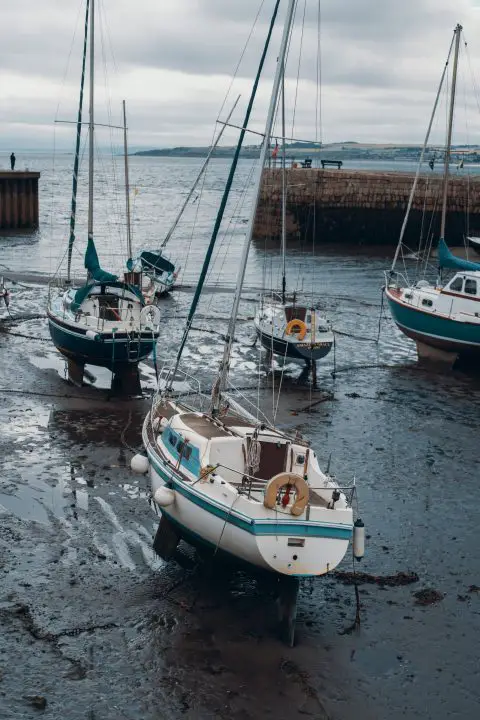
What Is a Boat Rudder?
The rudder is the underwater part of the boat that helps it turn and change direction. It’s mounted on the rear of the boat. When the wheel or tiller in the cockpit is turned, the rudder moves to one side or another. That, in turn, moves the boat’s bow left or right.
When it comes to sailing, rudders also offer a counterbalance to the underwater resistance caused by the keel. This enables the boat to sail in a straight line instead of just spinning around the keel.
Sailboat hull designs vary widely when you view them out of the water. But while the actual shape and sizes change, they all have two underwater features that enable them to sail–a rudder and a keel.
The rudder is mounted at the back of the boat and controls the boat’s heading or direction as indicated by the compass .
The keel is mounted around the center of the boat. Its job is to provide a counterbalance to the sails. In other words, as the wind presses on the sails, the weight of the ballast in the keel and the water pressure on the sides of the keel keeps the boat upright and stable.
When sailing, the keel makes a dynamic force as water moves over it. This force counters the leeway made by air pressure on the sails and enables the boat to sail windward instead of only blowing downwind like a leaf on the surface.
The rudder is a fundamental feature of all boats. Early sailing vessels used a simple steering oar to get the job done. Over the years, this morphed into the rudder we know today.
However, thinking about a rudder in terms of a steering oar is still useful in understanding its operation. All it is is an underwater panel that the helmsperson can control. You can maintain a course by trailing the oar behind the boat while sailing. You can also change the boat’s heading by moving it to one side or the other.
The rudders on modern sailboats are a little slicker than simple oars, of course. They are permanently mounted and designed for maximum effectiveness and efficiency.
But their operating principle is much the same. Rudders work by controlling the way water that flows over them. When they move to one side, the water’s flow rate increases on the side opposite the turn. This faster water makes less pressure and results in a lifting force. That pulls the stern in the direction opposite the turn, moving the bow into the turn.
Nearly all boats have a rudder that works exactly the same. From 1,000-foot-long oil tankers to tiny 8-foot sailing dinghies, a rudder is a rudder. The only boats that don’t need one are powered by oars or have an engine whose thrust serves the same purpose, as is the case with an outboard motor.
Operating the Rudder on a Sailboat
Rudders are operated in one of two ways–with a wheel or a tiller. The position where the rudder is operated is called the helm of a boat .
Ever wonder, “ What is the steering wheel called on a boat ?” Boat wheels come in all shapes and sizes, but they work a lot like the wheel in an automobile. Turn it one way, and the boat turns that way by turning the rudder.
A mechanically simpler method is the tiller. You’ll find tiller steering on small sailboats and dinghies. Some small outboard powerboats also have tiller steering. Instead of a wheel, the tiller is a long pole extending forward from the rudder shaft’s top. The helmsperson moves the tiller to the port or starboard, and the bow moves in the opposite direction. It sounds much more complicated on paper than it is in reality.
Even large sailboats will often be equipped with an emergency tiller. It can be attached quickly to the rudder shaft if any of the fancy linkages that make the wheel work should fail.
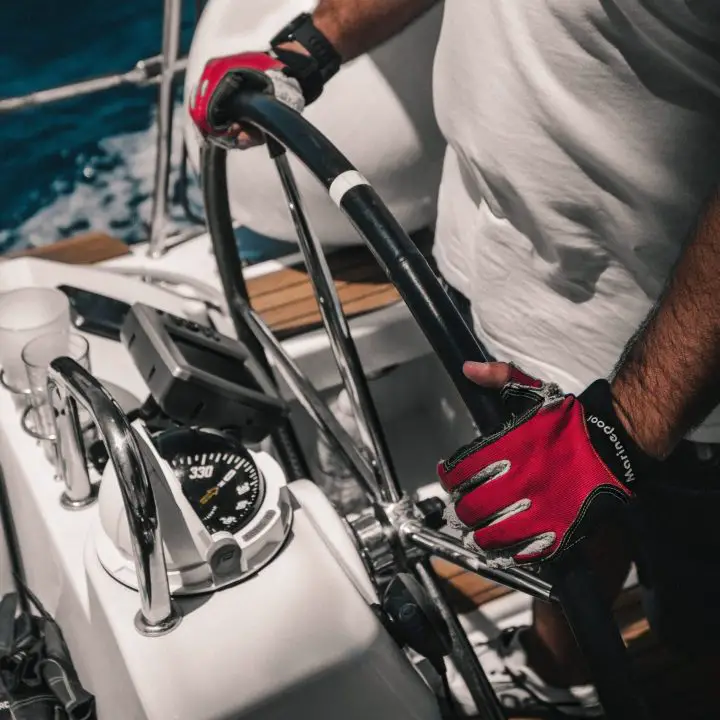
Various Sail Boat Rudder Designs
Now, let’s look at the various types of rudders you might see if you took a virtual walk around a boatyard. Since rudders are mostly underwater on the boat’s hull, it’s impossible to compare designs when boats are in the water.
Keep in mind that these rudders work the same way and achieve the same results. Designs may have their pluses and minuses, but from the point of view of the helmsperson, the differences are negligible. The overall controllability and stability of the boat are designed from many factors, and the type of rudder it has is only one of those.
You’ll notice that rudder design is closely tied to keel design. These two underwater features work together to give the boat the sailing characteristics the designer intended.
The classic, robust offshore sailboat is designed with a full keel that runs from stem to stern. With this sort of underwater profile, it only makes sense that the rudder would be attached to the trailing edge of that enormous keel. On inboard-powered sailboats, the propeller is usually mounted inside an opening called the aperture between the keel and rudder.
The advantages of this design are simplicity and robustness. The keel is integrated into the hull and protects the rudder’s entire length. Beyond reversing into an obstacle, anything the boat might strike would hit the keel first and would be highly unlikely to damage the rudder. Not only does the keel protect it, but it also provides a very strong connection point for it to be attached to.
Full keel boats are known for being slow, although there are modern derivatives of these designs that have no slow pokes. Their rudders are often large and effective. They may not be the most efficient design, but they are safe and full keels ride more comfortably offshore than fin-keeled boats.
Plenty of stout offshore designs sport full keel rudders. The Westsail 38s, Lord Nelsons, Cape Georges, Bristol/Falmouth Cutters, or Tayana 37s feature a full keel design.
A modified full keel, like one with a cutaway forefoot, also has a full keel-style rudder. These are more common on newer designs, like the Albergs, Bristols, Cape Dorys, Cabo Ricos, Island Packets, or the older Hallberg-Rassys.

A design progression was made from full keel boats to long-fin keelboats, and the rudder design changed with it. Designers used a skeg as the rudder became more isolated from the keel. The skeg is a fixed structure from which you can mount the rudder. This enables the rudder to look and function like a full keel rudder but is separated from the keel for better performance.
The skeg-hung rudder has a few of the same benefits as a full keel rudder. It is protected well and designed robustly. But, the cutaways in the keel provide a reduced wetted surface area and less drag underwater, resulting in improved sailing performance overall.
Larger boats featuring skeg-mounted rudders include the Valiant 40, Pacific Seacraft 34, 37, and 40, newer Hallberg-Rassys, Amels, or the Passport 40.
It’s worth noting that not all skegs protect the entire rudder. A partial skeg extends approximately half the rudder’s length, allowing designers to make a balanced rudder.
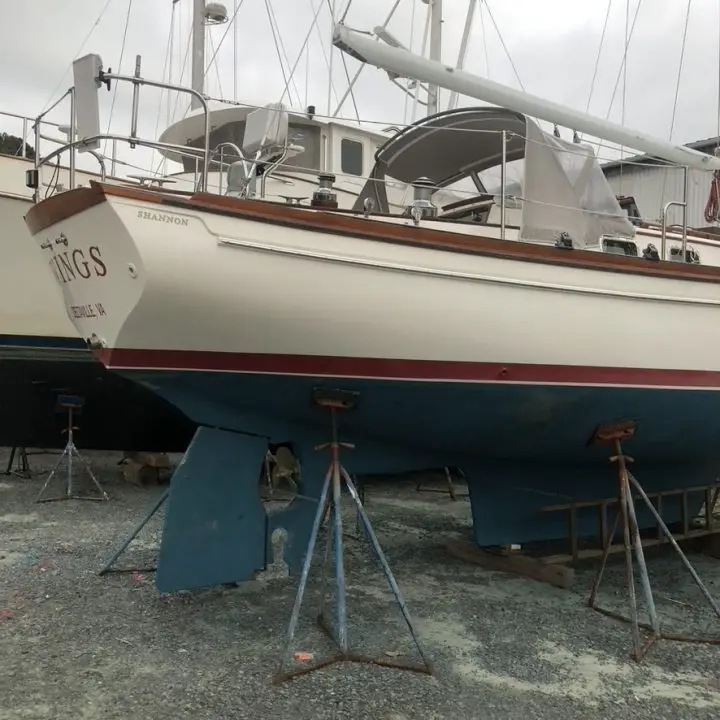
With higher-performance designs, keels have become smaller and thinner. Fin keel boats use more hydrodynamic forces instead of underwater area to counter the sail’s pressure. With the increased performance, skegs have gone the way of the dinosaurs. Nowadays, rudders are sleek, high aspect ratio spade designs that make very little drag. They can be combined with a number of different keel types, including fin, wing keels , swing keels, or bulb keels.
The common argument made against spade rudders is that they are connected to the boat by only the rudder shaft. As a result, an underwater collision can easily bend the shaft or render the rudder unusable. In addition, these rudders put a high load on the steering components, like the bearings, which are also more prone to failure than skeg or full keel designs. For these reasons, long-distance cruisers have traditionally chosen more robust designs for the best bluewater cruising sailboats .
But, on the other hand, spade rudders are very efficient. They turn the boat quickly and easily while contributing little to drag underwater.
Spade rudders are common now on any boat known for performance. All racing boats have a spade rudder, like most production boats used for club racing. Pick any modern fin keel boat from Beneteau, Jeanneau, Catalina, or Hunter, and you will find a spade rudder. Spade rudders are common on all modern cruising catamarans, from the Geminis to the Lagoons, Leopards, and Fountaine Pajots favored by cruisers and charter companies.
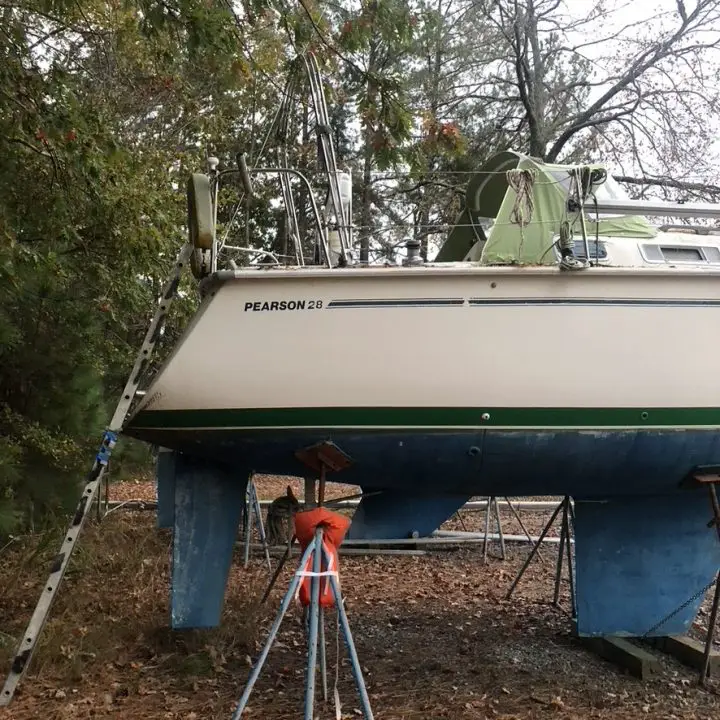
Here are two alternative designs you might see out on the water.
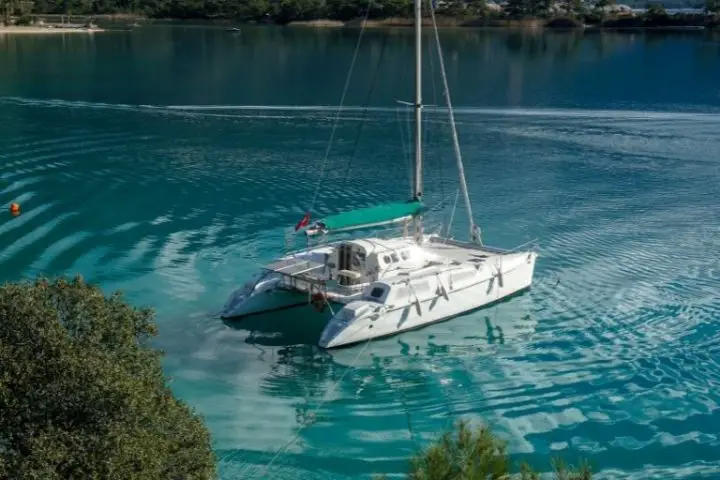
Transom-Hung or Outboard Rudders
An outboard rudder is hung off the boat’s transom and visible while the boat is in the water. Most often, this design is controlled by a tiller. They are common on small sailing dingies, where the rudder and tiller are removable for storage and transport. The rudder is mounted with a set of hardware called the pintle and gudgeon.
Most outboard rudders are found on small daysailers and dinghies. There are a few classic big-boat designs that feature a transom-hung rudder, however. For example, the Westsail 38, Alajuela, Bristol/Falmouth Cutters, Cape George 36, and some smaller Pacific Seacrafts (Dana, Flicka) have outboard rudders.
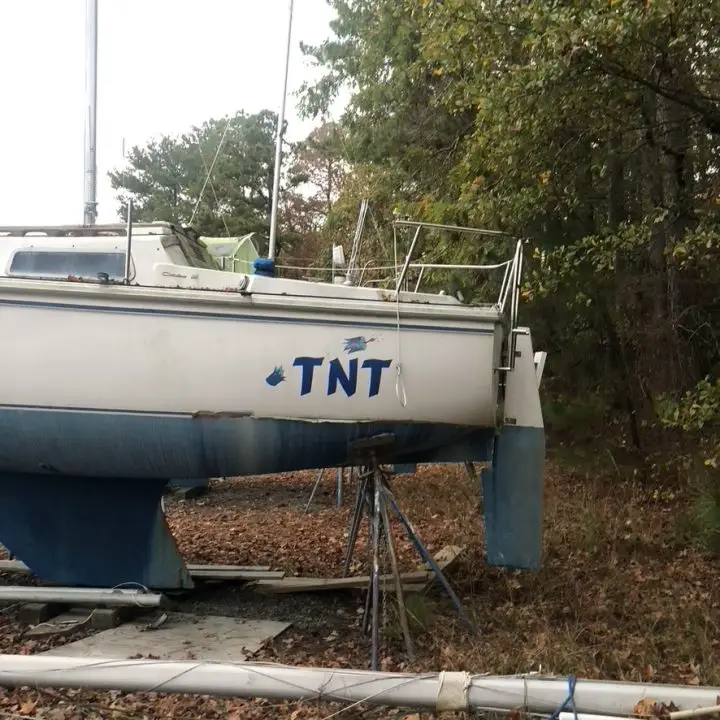
Twin Sailing Rudder Designs
A modern twist that is becoming more common on spade rudder boats is the twin sailboat rudder. Twin rudders feature two separate spade rudders mounted in a vee-shaped arrangement. So instead of having one rudder pointed down, each rudder is mounted at an angle.
Like many things that trickle down to cruising boats, the twin rudder came from high-performance racing boats. By mounting the rudders at an angle, they are more directly aligned in the water’s flow when the boat is healed over for sailing. Plus, two rudders provide some redundancy should one have a problem. The twin rudder design is favored by designers looking to make wide transom boats.
There are other, less obvious benefits of twin rudders as well. These designs are easier to control when maneuvering in reverse. They are also used on boats that can be “dried out” or left standing on their keel at low tide. These boats typically combine the twin rudders with a swing keel, like Southerly or Sirius Yachts do. Finally, twin rudders provide much better control on fast-sailing hulls when surfing downwind.
Unbalanced vs. Balanced Rudders
Rudders can be designed to be unbalanced or balanced. The difference is all in how they feel at the helm. The rudder on a bigger boat can experience a tremendous amount of force. That makes turning the wheel or tiller a big job and puts a lot of strain on the helmsperson and all of the steering components.
A balanced rudder is designed to minimize these effects and make turning easier. To accomplish this, the rudder post is mounted slightly aft of the rudder’s forward edge. As a result, when it turns, a portion of the leading edge of the rudder protrudes on the opposite side of the centerline. Water pressure on that side then helps move the rudder.
Balanced rudders are most common in spade or semi-skeg rudders.
Sail Rudder Failures
Obviously, the rudder is a pretty important part of a sailboat. Without it, the boat cannot counter the forces put into the sails and cannot steer in a straight line. It also cannot control its direction, even under power.
A rudder failure of any kind is a serious emergency at sea. Should the rudder be lost–post and all–there’s a real possibility of sinking. But assuming the leak can be stopped, coming up with a makeshift rudder is the only way you’ll be able to continue to a safe port.
Rudder preventative maintenance is some of the most important maintenance an owner can do. This includes basic things that can be done regularly, like checking for frayed wires or loose bolts in the steering linkage system. It also requires occasionally hauling the boat out of the water to inspect the rudder bearings and fiberglass structure.
Many serious offshore cruisers install systems that can work as an emergency rudder in extreme circumstances. For example, the Hydrovane wind vane system can be used as an emergency rudder. Many other wind vane systems have similar abilities. This is one reason why these systems are so popular with long-distance cruisers.
There are also many ways to jury rig a rudder. Sea stories abound with makeshift rudders from cabinet doors or chopped-up sails. Sail Magazine featured a few great ideas for rigging emergency rudders .
Understanding your sail rudder and its limitations is important in planning for serious cruising. Every experienced sailor will tell you the trick to having a good passage is anticipating problems you might have before you have them. That way, you can be prepared, take preventative measures, and hopefully never deal with those issues on the water.
What is the rudder on a sailboat?
The rudder is an underwater component that both helps the sailboat steer in a straight line when sailing and turn left or right when needed.
What is the difference between a rudder and a keel?
The rudder and the keel are parts of a sailboat mounted underwater on the hull. The rudder is used to turn the boat left or right, while the keel is fixed in place and counters the effects of the wind on the sails.
What is a rudder used for on a boat?
The rudder is the part of the boat that turns it left or right
Matt has been boating around Florida for over 25 years in everything from small powerboats to large cruising catamarans. He currently lives aboard a 38-foot Cabo Rico sailboat with his wife Lucy and adventure dog Chelsea. Together, they cruise between winters in The Bahamas and summers in the Chesapeake Bay.
Leave a comment
Your email address will not be published. Required fields are marked *
Save my name, email, and website in this browser for the next time I comment.

What is a Sailboat Rudder?

A sailboat rudder steers the boat. A rudder is a hinged fin or blade mounted on the stern of the vessel that turns side to side, and it's controlled by a tiller or a helm.
A rudder is one of the primary controls of a sailboat. When the boat moves forward through the water, the rudder causes friction on one side and changes the direction of the boat. Rudders are controlled by moving a tiller side to side or by a helm and a complex linkage system. Rudders are delicate and sometimes flush with and protected by the keel.
Table of contents
Identifying the Rudder
Rudders are connected to the sailboat using a hinge or a shaft. The rudder is always located in the water behind the boat, but some rudders have part of their structure exposed above the waterline. Rudders that aren't visible above the waterline are usually underneath the stern and controlled by a vertical shaft that descends through the bottom of the boat.
Rudder Design
Rudder design varies widely between boats. Some vessels have large, ornate rudders that are exposed above the waterline. Large rudders are common on catboats, canoe yawls, and other traditional designs.
Many modern boats use small, blade-like rudders that are hidden from view. The size of a rudder doesn't necessarily correlate with its effectiveness, but an improperly sized rudder can cause significant issues.
How Does a Sailboat Rudder Work?
Sailboat rudders are simple devices. Rudders are essentially deflectors, as they deflect water to port or starboard as the boat moves along. When the rudder is amidships or in the middle and aligned with the keel, the boat goes straight. Rudders also help keep the boat on a straight track as they increase the area of water moving down the length of the boat.
Rudders only work when the boat is moving. If there's no moving water to deflect, the rudder can do little to direct the vessel. Rudders also don't work when the boat is blown sideways. Maneuvering is only possible when the boat is moving forward.
Can a Sailboat Rudder Steer in Reverse?
But what about moving in reverse? Rudders can be used to steer the boat in reverse, but they're significantly less effective when pushed backward through the water. The distance required to make a turn in reverse is usually much higher than when moving forward, and steering input is less precise. In some cases, sailboat rudders can break off when moving too quickly in reverse.
Sailboat Steering Characteristics
Sailboats steer much differently than cars, and there aren't any brakes to slow down with. Sailboats tend to steer from the middle; picture a fan blade spinning slowly on a motor, and you'll get the picture. As a result, steering too aggressively in tight quarters can cause your bow or stern to hit something that's beside you.
Speed is generally helpful for steering, especially when you want to make precise movements quickly. However, speed is a double-edged sword, as slight rudder movement at speed can dramatically and rapidly alter the course of the boat. But remember, you can't steer without moving forward.
Tiller Steering
Sailboat rudders are often controlled by a tiller. Tillers are a long rod connected to the rudder. Sailors move the rod side to side from the cockpit to turn the rudder directly. Tillers are the simplest form or rudder control, and they're highly reliable. Tillers point in the opposite direction that the boat will travel.
Tiller steering is found most often on small boats. This is because the forces involved in steering boats of greater size can be too difficult to manage with a tiller. That said, there are some relatively large boats with cockpit configurations that allow for the use of a tiller. Sailboats with tillers range in size between 10 feet and 30 feet.
Benefits of a Tiller
Tillers have numerous benefits. Tillers offer precise control of the boat because they connect the rudder directly to the person steering the boat. Additionally, tillers are extremely simple and robust. Many blue water sailors prefer tiller steering, as it's difficult to break and easy to repair.
Over the years, sailors have developed many creative ways to make tillers more useful. Many boats feature tiller extensions that allow the sailor to steer from further away. Tillers also respond much faster than helms, which is great for racing and pushing the limits of the boat.
Tiller Self-Steering
Bluewater sailors developed an extremely useful way to multitask onboard a tiller-equipped sailboat. Self-steering is possible on vessels with a tiller, and no electronics or complex machines are necessary. Self-steering involves connecting the jib sheet to a series of pulleys and opposing bungee cord (or surgical tubing).
As the tension on the jib increases, it'll tighten the jib sheet and pull the tiller and change the course of the boat. The opposite is also true. This keeps the boat at the right angle to the wind and is useful for solo travel. GPS-guided self-steering equipment is also available for tiller-equipped sailboats, and it's relatively easy to install.
Helm Steering
A helm is essentially a large nautical steering wheel. Steering a boat with a helm is somewhat similar to driving a car, as the boat moves in the direction that you steer (unlike a tiller, which moves in the opposite direction). Sailboats equipped with tillers are usually larger. Some larger sailboats have two helms placed side-by-side in the cockpit.
The helm consists of a steering wheel and a pedestal which is mounted to the deck. Helm pedestals often feature a marine compass to make navigation possible from one location. Engine controls are often located nearby as well. Sailboat helms are often large in diameter, sometimes 30 inches or more. Large wheels make steering easy and precise.
Helm-equipped sailboats are generally 30-feet long and larger. Tillers are excellent for large boats, as they enable precise movement and require little effort to use. This is especially important at speed when the force of water rushing by a large rudder can be too difficult to overcome with a tiller.
The helm is connected to the rudder mechanically or hydraulically. Some high-end sailboats incorporate power steering, but this is unusual on most consumer vessels. Mechanical helm linkage typically utilizes a cable (or multiple cables and pulleys) that stretches from the helm to the rudder.
Hydraulic Rudder Control
Most sailboat helms are hydraulic. These helms use pressurized hydraulic fluid and small diameter lines to replicate the wheel movements at the rudder. Hydraulic systems often include a fluid reservoir and a pressure cylinder, along with mechanical parts to transfer the force at the wheel and the rudder.
Rudder Maintenance
Rudder maintenance is fairly simple and should be performed regularly. As with the hull, rudders are an ideal habitat for all kinds of unwelcome marine life. Within a year or less, your rudder can be completely encapsulated in barnacles, plants, and other organisms. Marine growth will negatively impact your speed and steering, so it must be scraped off regularly.
Maintaining the steering system is also essential. Tillers are relatively easy to maintain, as they use very few moving parts. Look for grease fittings, and make sure your tiller and rudder are fastened tightly. Helms are more complex, and the hydraulic system should be inspected, repaired, and topped off if necessary.
What to Do if the Rudder is Damaged
Rudder damage is a sailor's worst nightmare, and it's akin to a hole in the hull or losing a mast. So what should you do if your rudder gets damaged or breaks off? First, call for help! But if help isn't available, there are a few makeshift ways to steer the boat without the rudder.
If you have an outboard motor, use it to steer. If not, then a run-of-the-mill rowboat oar makes an excellent rudder substitute. Simply lash the oar to the back of the boat with the end in the water, and use it like a tiller. It's not ideal, but it worked for the Romans, and it should work for you. Some sailors have fashioned makeshift rudders from interior cabinet doors, hatches, scrap metal, and whatever else is on hand.
Losing a rudder is a worst-case-scenario, and it doesn't often happen when sailors keep up with maintenance and stay away from dangerous water. Preventative maintenance and proper navigation are the best ways to keep your rudder in good shape.
Related Articles
Daniel Wade
I've personally had thousands of questions about sailing and sailboats over the years. As I learn and experience sailing, and the community, I share the answers that work and make sense to me, here on Life of Sailing.
by this author
Sailboat Parts
Learn About Sailboats
Most Recent

What Does "Sailing By The Lee" Mean?
October 3, 2023

The Best Sailing Schools And Programs: Reviews & Ratings
September 26, 2023
Important Legal Info
Lifeofsailing.com is a participant in the Amazon Services LLC Associates Program, an affiliate advertising program designed to provide a means for sites to earn advertising fees by advertising and linking to Amazon. This site also participates in other affiliate programs and is compensated for referring traffic and business to these companies.
Similar Posts

Affordable Sailboats You Can Build at Home
September 13, 2023

Best Small Sailboat Ornaments
September 12, 2023

Discover the Magic of Hydrofoil Sailboats
December 11, 2023
Popular Posts

Best Liveaboard Catamaran Sailboats
December 28, 2023

Can a Novice Sail Around the World?
Elizabeth O'Malley
June 15, 2022

4 Best Electric Outboard Motors

How Long Did It Take The Vikings To Sail To England?

10 Best Sailboat Brands (And Why)
December 20, 2023

7 Best Places To Liveaboard A Sailboat
Get the best sailing content.
Top Rated Posts
© 2024 Life of Sailing Email: [email protected] Address: 11816 Inwood Rd #3024 Dallas, TX 75244 Disclaimer Privacy Policy
- Anchoring & Mooring
- Boat Anatomy
- Boat Culture
- Boat Equipment
- Boat Safety
- Sailing Techniques
Rudder Revolution: The Ultimate Guide to Boat Rudders
A rudder is a critical component of a sailboat, allowing the boat to steer and change direction. Without one, a sailboat would be at the mercy of the wind and waves, making it nearly impossible to navigate and control.
A rudder is a flat blade attached to the stern of a boat that can be turned to change the boat’s direction. There are several types, each with unique characteristics, advantages, and disadvantages. This article will closely examine a rudder’s purpose, history, parts, styles, and function.
Key Takeaways
- A sailboat rudder is a flat plate or blade attached to a boat's stern, used to control the boat's direction and enhance its stability and performance.
- The rudder's design has evolved over time, and modern advances in materials and technology have led to further improvements in its function and efficiency.
- Different types of rudders include full-spade, semi-balanced, and skeg-hung, each with varying sizes and shapes depending on their purpose.
- The rudder consists of four primary components: the shaft, blade, tiller, and stock, all of which must be precisely aligned and maintained for optimal performance.
What is a sailboat rudder?
A sailboat rudder is a flat plate or blade attached to a boat’s stern . It is usually made of wood, fiberglass, or metal, and it can vary in size and shape depending on the type of boat. Different types of rudders, including spade, transom-hung, and balanced rudders, serve another purpose.
The purpose of a rudder is to control the boat’s direction as it helps stability and enhances the boat maintain s performance. It also enables the boat to manoeuvre in tight spaces like harbors and marinas. A rudder is essential for navigation and improves safety and maneuverability.
History of the boat rudder
The concept of the rudder has been around for thousands of years, and its design has evolved. The rudder was a simple, unbalanced blade fastened outside the hull in ancient times.
It became a more balanced design during the Middle Ages, allowing for better control and manoeuvrability. In modern times, advances in materials and technology have led to further improvements in design.
In the modern era, shipbuilding and navigation technology have advanced significantly, resulting in more refined and efficient rudders. This is evident in hydraulic and electronic steering systems, which give sailors greater control over their sailboats.
One of the most notable innovations is improved materials, such as fibreglass and composites. These materials are stronger, lighter, and more durable than traditional materials, making sailboats more accessible and enjoyable for a broader range of people.
Another example of recent innovation is the use of advanced steering systems, such as self-feathering propellers and retractable rudders. These systems have revolutionized how sailboats are controlled, providing sailors greater control and maneuverability in all conditions.
The rudder is also critical in competitive sailing, where the design and performance can often determine the outcome of a race. In this high-stakes environment, sailors depend on precise control and manoeuvrability, especially in challenging conditions such as strong winds and rough seas.
For example, the America’s Cup, one of the world’s oldest and most prestigious sailing events, is a testament to the importance of rudder technology in competitive sailing.
In recent years, America’s Cup has seen cutting-edge designs and technology, including advanced materials, hydraulic and electronic steering systems, and even wings and foils to increase stability and speed.
Similarly, the Volvo Ocean Race, a round-the-world sailing race, demonstrates rudder technology’s importance in competitive sailing. The harsh conditions encountered during the race, including high winds and rough seas, require advanced steering systems to ensure the sailors’ and their ships’ safety and success.
How does a rudder work?
Boats have rudders because they are essential for navigation. The rudder allows the ship to turn in the desired direction, making it easier to steer and avoid obstacles.
They also improve safety and manoeuvrability and increase the ship’sefficiency and speed. A sailboat rudder works by directing the flow of water.
The rudder is turned by a mechanism, such as a tiller or a wheel, and this movement changes the direction of the water flow, causing the boat to turn in the desired order. The forces acting on it include the water flow, the wind, and the boat’s movement.
As mentioned, its primary function is to steer the boat and control its direction, keeping it on course by adjusting to changes in wind and currents. When the tiller is turned, the blade moves to one side, creating a turning force and causing the boat to change direction.
The rudder also helps to increase stability by reducing the boat’s roll and improving its handling in rough conditions. Turning the rudder in the opposite direction to that of the turn rises stability, helping to ensure smooth, controlled manoeuvring. Setting the correct angle when turning is essential, as too much or too little can cause instability or lack of control.
By redirecting the flow of water around the hull, the rudder creates a force that reduces roll, or the side-to-side movement of the boat, which can make sailing difficult. Additionally, having control over that force enables sailors to adjust the course of their vessel quickly and precisely in even the most challenging waters.
Types of rudders
The full-spade rudder is a popular choice for many sailors, characterized by its large, spade-shaped design that extends down into the water. It offers increased control and manoeuvrability due to its expansive surface area, making it easier for the sailor to make quick and precise turns.
It also provides increased stability, allowing the boat to withstand choppy waters or high-speed turns more easily. However, its large size can cause drag, reducing the boat’s efficiency, and it is more vulnerable to damage in shallow water due to its size.
Semi-balanced
Sailors who want a good balance of control and stability often choose the semi-balanced rudder, which is more compact than its full-spade counterpart. It offers improved maneuverability due to its streamlined shape and reduced drag, allowing the boat to move quickly through the water.
Additionally, it provides a reasonable degree of stability, making it suitable for sailors who don’t require maximum control in turbulent conditions.
However, a few drawbacks are also worth noting. The semi-balanced rudder has less stability than the full-spade model and can be more fragile in rough waters . Additionally, its smaller size decreases control and may not be suitable for experienced sailors who need maximum manoeuvrability.
The skeg-hung rudder is an excellent choice for sailors prioritising stability and efficiency. This type has a large blade mounted on a long, narrow fin that extends downward from the boat’s hull, which provides stability and reduces drag. The key advantages of this design are greater stability in rough conditions and improved speed and efficiency.
However, this style is less manoeuvrable than full-spade or semi-balanced, so there may be better choices for sailors looking to make quick and precise turns. Additionally, the skeg-hung version may be more susceptible to damage when navigating shallow or rocky waters, such as groundings or impacts.
Boats with two rudders are designed to offer improved control, stability, and performance. The two are typically located near the stern of the boat, on either side of the keel. The broader base created by two rudders can help improve stability in rough conditions and allow for more precise navigation and quick course adjustments.
This can be especially important for competitive sailing events where performance is essential. Catamarans and trimarans are often explicitly designed with multiple rudders, while some larger vessels may use two to provide increased control and maneuverability in stronger winds or choppy seas.
Parts of a rudder
The rudder of a boat consists of four primary components – the shaft, blade, tiller, and stock. The vertical shaft connects the blade to the stern and allows up-and-down movements. The horizontally-oriented blade provides turning force when pushed by water flow.
Attached to the shaft is a lever known as the tiller, which controls direction. Finally, the stock is fixed onto the vessel’s stern and kept in place while allowing directional changes.
The shaft is essential for connecting the blade of a rudder to a boat. It’s crucial to select the suitable material for the shaft depending on what kind of sailing will be done. Marine grade stainless steel, aluminium, and composite materials are all common choices. The alignment of the shaft must be precise for efficient steering; if it is misaligned, manoeuvring the vessel can become difficult.
Understanding the shape and design of the blade is essential for ensuring your boat operates effectively. Different types of blades, such as curved, flat, and spoon-shaped, can be chosen based on the size of your vessel and the sailing you will be doing.
A well-designed blade provides efficient control and stability, while a poorly designed one may make it difficult to control. Choosing the right blade is essential in getting optimal performance from your vessel.
The tiller is essential to the boat’s steering system , as it connects and provides force to the rudder shaft. The alignment and tension of the tiller must be carefully adjusted to ensure smooth and effective direction control. If these components are adjusted correctly, it can result in excellent or smooth steering movements, which can be detrimental to the safety and performance of your vessel.
The stock is an integral part of the assembly and is responsible for transmitting tiller force to the blade. It must be securely attached to the boat’s hull to provide proper control and direction. A properly connected stock guarantees that your vessel will respond correctly when turned with the tiller.
The rudder is essential to any sailboat, providing critical steering and control that enables boats or ships to navigate successfully and safely. Over the centuries, the design and technology have evolved significantly, from simple steering oars to more advanced self-feathering propellers and retractable units.
Understanding different types, their function, and how to maintain them is vital for safe sailing. From wooden sailboats to modern racing yachts, the rudder continues to be a necessary part of navigation, ensuring stability and manoeuvrability. As technology continues to evolve, boaters can look forward to even more efficient and advanced rudders in the future.
Q: What is the purpose of a rudder on a boat?
A: The purpose of a rudder on a boat is to steer and maintain its direction. It helps the boat change direction by creating a turning force when the tiller is turned, and it increases stability by reducing the boat’s roll and improving its handling in rough conditions.
Q: How does a rudder work?
A: A rudder creates a turning force when the tiller is turned. The blade moves to one side, causing the boat to change direction. It also helps to increase stability by reducing the boat’s roll and improving its handling in rough conditions.
Q: What are the parts of a rudder?
A: The parts include the shaft, blade, tiller, and stock. The shaft connects the blade to the boat while the blade creates a turning force when moved across one side. The tiller is then used as a lever to steer while the stock attaches it all to the stern of your boat.
Q: What are the different types of rudders?
A: There are three main types of rudders – full-spade, semi-balanced, and skeg-hung – each with varying sizes and shapes depending on their purpose. Full-spade have large blades that extend below your hull, while semi-balanced ones have smaller ones that partially extend beneath them. Meanwhile, Skeg-hung has smaller blades attached to a skeg that extends below your hull.
Q: How does a rudder affect the performance of a boat?
A: A properly maintained rudder positively affects performance by providing precise control over steering and better control in choppy waters due to increased stability from reduced rollover risk. Poorly working rudders, however, can make controlling your vessel difficult, which can then lead to decreased performance overall
Steer clear of trouble: Boating in shoals
Understanding weather helm and its dangers, related posts, understanding the boom of a boat, understanding the importance of boat chines, hull speed calculator.
- Cookie Policy
- Privacy Statement
© 2023 TIGERLILY GROUP LTD, 27 Old Gloucester Street, London, WC1N 3AX, UK. Registered Company in England & Wales. Company No. 14743614
Welcome Back!
Login to your account below
Remember Me

Retrieve your password
Please enter your username or email address to reset your password.
Add New Playlist
- Select Visibility - Public Private
Top 5 Maritime Tech startups in Australasia

U.S. Coast Guard returns 109 migrants to Dominican Republic
Video: houthis capture greek oil tanker in red sea, why do somali pirates hijack ships.
- crew change crisis
- crew change
- Marine Education
Video: How Does a Ship’s Rudder Work?
The rudder evolved from a steering board that was used in ancient times. The steering board was usually mounted on the right-hand side to suit right-handed sailors.
With the advancement of technology and enhancement in ships’ designs, the steering board moved onto the centre line through a stock passing through the vessel. A tiller was then attached to the stock allowing sailors to control the rudder from the main deck. The basic setup continued right up until modern times.
The above picture shows the rudder of the Olympic, and it is evident from the picture that it carries the same characteristics as the original steering board. It’s a small flat board mounted on a stock passing through the ship. Let’s understand how this works.
All this means that for a given speed of water, the curved airfoil shaped rudder will turn a boat more efficiently than a flat rudder.
With all of the rudders that we have talked about, we saw that the water flow is needed for them to work at all. On a sailing boat the boat needs to be moving for the rudder to have any effect. On a motor boat, or on ships powered by engines, there are two options, either the ship needs to be moving through the water or the propeller needs to be turning, pushing water across the rudder.
If you are trying to manoeuvre at slow speeds, you don’t want to have the engine running all the time as you are going to pick up the speed, you can use small bursts from the engine to generate the same effect. You move the rudder over, give a kick ahead, you will get the same turning effect while minimizing the build-up of speed.
Share this:
- Click to share on WhatsApp (Opens in new window)
- Click to share on Facebook (Opens in new window)
- Click to share on X (Opens in new window)
- Click to share on Telegram (Opens in new window)
- Click to share on LinkedIn (Opens in new window)
- Click to share on Reddit (Opens in new window)
- how does a ship turn in water
- how rudder works
- rudder of ship
- ship turning
- ship's rudder
Interesting video! I never realized how important the rudder is to a ship’s navigation. It’s fascinating to see how it works and the different types of rudders used in different vessels. Thanks for sharing this informative post!
Leave a Reply Cancel reply
Your email address will not be published. Required fields are marked *
Save my name, email, and website in this browser for the next time I comment.
This site uses Akismet to reduce spam. Learn how your comment data is processed .
Sign Up for Our Newsletters
Related posts, shipowners’ wage cuts plan a slap in the face for pandemic heroes: itf, watch: italy’s largest container port reopens after msc boxship refloats, suez canal authority chief proposes expansion of canal after ever given incident, japan considering alternatives to suez canal after ever given incident.
Building, restoration, and repair with epoxy

How to Build Rudders & Centerboards
by Captain James R. Watson
When the centerboard of my Searunner trimaran broke in the middle of a windy race around the Black Hole, the question I kept asking was “Why now, after working fine all of this time, and when we were leading the race?”
“Guess it just wore out” was my excuse to myself. This centerboard was built of laminated layers of plywood, resulting in a thickness of 2″. It was then covered with two layers of 6-oz woven fiberglass fabric. It was a deep and wide board with a lot of area, and like any rudder or centerboard on a boat that is sailed hard, it was exposed to a fair amount of stress.
The answer to “Why now – while leading the race?” could have been fate. But there is a more scientific answer. Extensive laboratory testing at Gougeon Brothers, Inc. defines why the centerboard failed. Understanding why can help us design and construct components that will perform more efficiently and last much longer.
The plywood centerboard did, in fact, wear out – or more accurately – it failed from rolling shear fatigue. Fatigue cracks in a material result from repeated (cyclic) stress. Fatigue is a reality of all structures and materials and eventually culminates in structural failure. Repeated loading and unloading or even worse, loading one way and then the other (reverse axial), rapidly reduces a material’s physical integrity and accelerates degradation. The higher the load is as a percentage of the material’s ultimate strength, the more rapid is the deterioration.
Some materials have a greater fatigue life than others. Ounce per ounce, wood is capable of operating at a much higher percentage of its ultimate stress level than most other materials. That is why such wonderfully efficient structures can be built with wood. However, plywood is not a good choice for cantilevered structures such as rudder blades and centerboards. This is because plywood is susceptible to rolling shear, shearing forces that roll the structural fibers across the grain. Plywood’s unidirectional wood fibers are laid in alternating layers, approximately half of them are oriented 90 degrees to the axis of the loads. Like a bundle of soda straws, which resist bending moments quite well one way, they simply lack cross-grain strength laterally and can roll against one another and fail under relatively low stress, especially in a cyclic environment. Therefore, when anticipated loads are primarily unidirectional, it is ideal to use a material with good unidirectional strength. Since only half of the plywood’s wood fiber is used to advantage, a plywood rudder blade or centerboard going from tack to tack (reverse axial loads) will fatigue much more rapidly than one built as described in this article.
If you were to look at the end of the board, say a fish’s view of a centerboard or rudder blade, you’d view its cross-section. A section that has a faired airfoil shape is preferred over one that is flat with parallel sides. This is because the airfoil shape produces lift when moving through the water, thereby counteracting the sideward forces exerted by the sail rig. A flat section produces less lift and at a great expense of drag, slowing the boat and making it more difficult to steer.
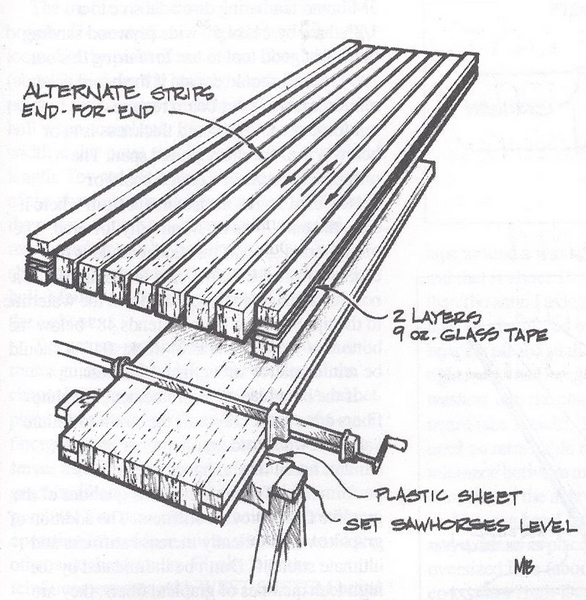
“Turn every other ripping end-for-end to neutralize the effects of any grain that does not run exactly parallel to the blank, and to reduce tendencies to twist. Rotate the rippings 90 degrees to expose the vertical grain and to permit easier shaping with a plane.
The selection of a proper camber and section can be a subject of great theoretical debate. One can become intimidated with technical terms such as thickness distribution, Reynolds number, boundary layer, and so on. These terms do relate to the subject, however, for the builder/sailor whose boat floats forlornly in need of a rudder blade the following will do just fine. In fact, the best designers and builders will be hard-pressed to do better.
An excellent choice for most craft is a realistically accurate and fair NACA (National Advisory Committee for Aeronautics) 0012 airfoil, where maximum board thickness is 12% of the fore/aft length (chord length). Maximum thickness is located about 30% of the chord length measured from the leading edge (see sketch). The dimensions used to establish a specific shape (called offsets) are given in the appendix of Abbott & Doenhoff’s The Theory of Wing Sections. You’ll also find further information in my article How to loft Airfoil Sections.
From offsets make a good drawing of half the section on transfer paper.
Western red cedar and redwood are good choices of wood to use for rudder blades and centerboards for boats up to 25 feet. Both of these woods bond very well are generally clear and straight-grained, have good dimensional stability, are easily worked and affordable. Cedar is just a little heavier than the foams used for rudders, is much stiffer, and has far greater shear strength values. On larger craft, a higher-density material like African mahogany is a better choice. Oak is not a good choice.
Buy flat-grained 2’x6″s or 2’x8″s, and then rip them to the designed board thickness. Turn every other ripping end-for-end to neutralize the effects of any grain that does not run exactly parallel to the blank, and to reduce tendencies to warp or twist (see sketch). Rotating the rippings 90 degrees to expose vertical grain will permit easier shaping with a plane. The last trick is to rip the end pieces of the nose and tail in half. Bonding with a couple of layers of glass tape between keeps the fine edge of the tail from splitting too easily and offers a precise centerline.
Bond the ripping with a slurry of epoxy and 404 High-Density filler. Plastic strips prevent inadvertent bonding to leveled sawhorses (see sketch). With both sawhorses leveled, you’re positive no twist exists in the laminated blank. Bar clamps should be snugged until excess glue squeezes from the joints. Over tightening only stresses joints and tends to squeeze all the adhesive from them. When the laminate is cured, a light planing to clean the surfaces is all that is needed before shaping begins.
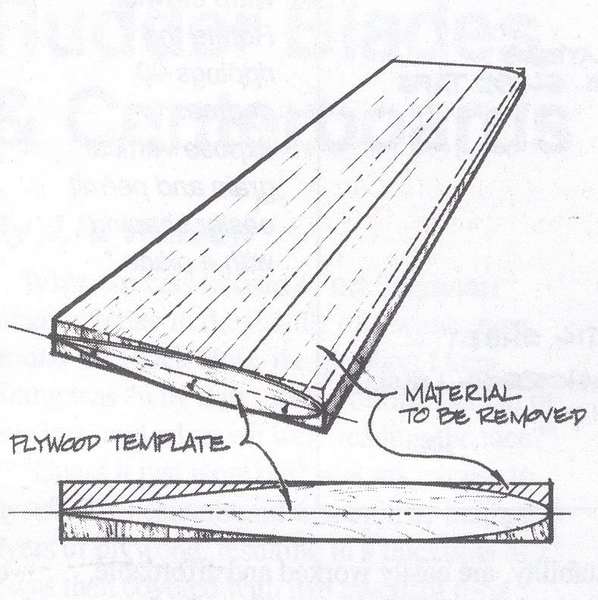
Centerboards and rudder blades are often overlooked components that are vital to a boat’s performance.
First, tack the 1/8″-thick plywood template that describes the cross-section shape to the blank’s ends. This is sawn from the impression made when traced with the transfer paper you originally drew it on. The key to producing an accurate and symmetrical board is maintaining a systematic removal of material from one side, then from the other. To do this, mark the shape to be removed, stick to straight-line shapes (see sketch). Use a smoothing plane to remove the wood.
After planing to the guidelines on one side, flip the blank over and plane the same shape on the other side. The procedure is similar to producing a round shape from a square by first forming an octagon, and then flattening the resulting eight corners to produce a 16-sided shape and refining that until very minute flat surfaces exist. Fifty-grit sandpaper bonded with 3M brand feathering disc adhesive to a 1/2″-thick by 11’x4.5″-wide plywood sanding block is a good tool to use for fairing this out.
Now you should decide if the board needs reinforcement. Your board requires reinforcement if the chord thickness is at or below 4% of the unsupported span. The unsupported span of a daggerboard or centerboard is that measurement from where it exits the hull, to its tip when fully lowered. The unsupported span of the rudder blade is the distance from the rudder case to the tip. If it is a non-retracting blade, measure from the waterline to the tip. So, if the board extends 48″ below the bottom of the hull and is 2″ thick, .04″, it should be reinforced for strength and stiffness.
If the board needs reinforcement, graphite fibers are a good choice as the strain-to-failure values of wood and graphite fiber are quite similar, hence they enhance each other’s performance. The high-modulus qualities of the graphite fibers provide stiffness. The addition of graphite will efficiently increase stiffness and ultimate strength. Don’t be intimidated by the high-tech qualities of graphite fibers, they are easy to work with.
The amount of reinforcement needed is usually figured at 10% chord thickness. Using the same board for our example, the board is 2″ thick, then 10% equals .20″ total reinforcement, .10″ per side. Graphite fiber tows are .01″ thick, so 10 tows per side should give the necessary reinforcement to do the job.
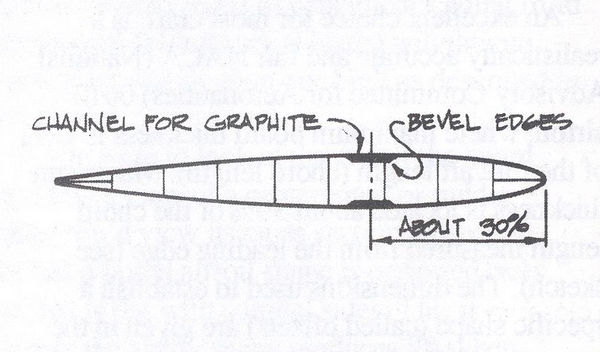
The graphite fibers will be laid into a channel routed into the shaped centerboard.
The graphite fibers will be laid into a channel that is routed into the shaped board (see sketch). The specific depth of the channel is determined by the above rule. Make the channel a little deeper than what’s required (1/16″) so you won’t be sanding the graphite fibers.
The profile of the channel is similar on all boards. The centerline of the channel is usually located at the point of maximum chord thickness (about 30% from the leading edge). The widest point of the channel is where the board exits the hull when completely lowered. The channel width at this point should be about 16% of chord length. Toward the ends of the board, the width of the channel narrows by about one-third that of the widest dimension. Keeping this in mind, more graphite can be laid in that area, a little above and more below that point that exits the hull. Maintain a consistent channel depth throughout.
Take a one-inch-square stick to serve as a router guide. It’s best to bevel the edge of the channel to reduce stress concentration. A rabbet plane serves best for this task. A layer of 6-oz fiberglass cloth is laid in the channel first (this serves as an interface between the wood and graphite fiber), followed by the schedule of graphite. You can complete the entire bonding operation for a side in one session. Try to do the other side the next day. Finally, fair the reinforcement area with WEST SYSTEM brand epoxy and a low-density filler.
A layer of 6-oz woven-glass fabric should then be bonded to the faired board to improve the cross-grain strength and abrasion resistance. The radius of the leading edge should be about a 1% radius of the chord length, and may not permit the fiberglass fabric to lie flat around the radius. In that event, cut a strip of woven glass fabric on the bias (which will lie around a tighter radius) and bond it around the leading edge.
It is better to leave the trailing edge slightly squared rather than razor-sharp. This will cause less drag and the centerboard will be less vulnerable to damage. Flatten the trailing edge to 1/16 or 1/8 of an inch on small boards, and closer to 1/4 of an inch on larger boards.
Any board, no matter how stiff, will deflect. To prevent the axle hole that the centerboard pivots on from binding when deflection occurs, make the hole somewhat larger than the pin diameter. The perimeter of the axle hole should be thoroughly protected with fiberglass, as exposed end grain can absorb moisture.
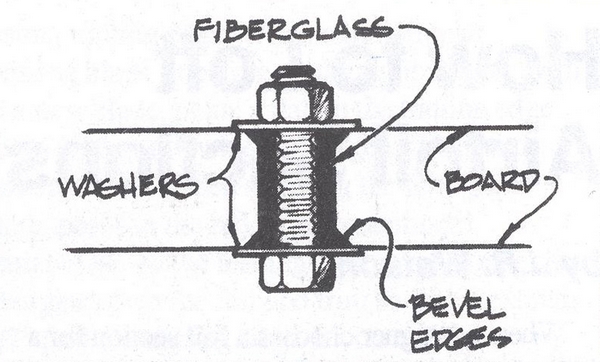
To prevent the axle hole from binding when deflection occurs, make the hole a little larger than the pin diameter.
Abrasion of the axle against the axle hole dictates that you should bond fiberglass into the hole’s perimeter. To do that, wrap fiberglass tape around a waxed (use auto paste wax) metal rod that is about 10 to 15% larger in diameter than the actual axle pin. The hole should be heavily chamfered on each side, so when the wet layup is placed in the hole and the nuts tightened, the fiberglass is pressed by the large washers into the chamfers on both sides of the board (see sketch). The same procedure may be used on retractable rudder blades, but the tolerance between axle hole diameter and the diameter of the axle pin should be closer.
You can bond control lines for centerboards and rudders-in-place by wetting a slightly oversized hole (about 1.5″ to 2″ deep) with epoxy/404 High-Density filler mixture. It helps to mark the hole’s depth on the rope with vinyl electricians tape to serve as a guide. Then, after soaking that end of the rope to be bonded in epoxy for a minute or so, shove it in the full depth of the hole.
Centerboards and rudder blades are often overlooked components that are of vital importance to a boat’s performance. Built correctly, they will reliably operate with the efficiency of a fish’s fin, and you should note a measurable improvement in the quality of pointing and steering of your windship.
References:
1. Jozset Bodig, Ph.D., Benjamin A Jayne Ph.D., Mechanics of Wood and Wood Composites 2. Johnston, Ken, Some Thoughts on Rudder Sections , Multihulls Magazine (Jan/Feb 1980) 3. Eck Bransford, Everything You Ever Wanted To Know About 505 Fins 4. Lindsay, Mark, Centerboards and Rudders , Yacht Racing/Cruising Magazine (April 1981) 5. Abbott and Doenhoff, Theory of Wing Sections, Dover Publications, Inc. New York (1959) 6. Captain James R. Watson, How to Loft Airfoil Sections , Epoxyworks 1 (Fall 1992)
How to Build a Sailboat Rudder From Scratch

Introduction: How to Build a Sailboat Rudder From Scratch

Step 1: Previous Rudder

Step 2: Rebuild

Step 3: Sanding

Step 4: Fiberglass Layup

Step 5: First Layer and Sanding

Step 6: Additional Layers and Difficult Spots

Step 7: Notes of Caution

Step 8: Hardware Holes

Step 9: Painting

Step 10: The End!

- New Sailboats
- Sailboats 21-30ft
- Sailboats 31-35ft
- Sailboats 36-40ft
- Sailboats Over 40ft
- Sailboats Under 21feet
- used_sailboats
- Apps and Computer Programs
- Communications
- Fishfinders
- Handheld Electronics
- Plotters MFDS Rradar
- Wind, Speed & Depth Instruments
- Anchoring Mooring
- Running Rigging
- Sails Canvas
- Standing Rigging
- Diesel Engines
- Off Grid Energy
- Cleaning Waxing
- DIY Projects
- Repair, Tools & Materials
- Spare Parts
- Tools & Gadgets
- Cabin Comfort
- Ventilation
- Footwear Apparel
- Foul Weather Gear
- Mailport & PS Advisor
- Inside Practical Sailor Blog
- Activate My Web Access
- Reset Password
- Customer Service

- Free Newsletter

Blue Jacket 40 Used Boat Review

Catalina 270 vs. The Beneteau First 265 Used Boat Match-Up

Ericson 41 Used Boat Review

Mason 33 Used Boat Review

How to Create a Bullet-Proof VHF/SSB Backup

Tips From A First “Sail” on the ICW

Tillerpilot Tips and Safety Cautions

Best Crimpers and Strippers for Fixing Marine Electrical Connectors

Polyester vs. Nylon Rode

Getting the Most Out of Older Sails

How (Not) to Tie Your Boat to a Dock

Stopping Mainsheet Twist

Fuel Lift Pump: Easy DIY Diesel Fuel System Diagnostic and Repair

Ensuring Safe Shorepower

Sinking? Check Your Stuffing Box

What Do You Do With Old Fiberglass Boats?

Boat Repairs for the Technically Illiterate

Boat Maintenance for the Technically Illiterate

Whats the Best Way to Restore Clear Plastic Windows?

Stopping Holding-tank Odors

Giving Bugs the Big Goodbye

Galley Gadgets for the Cruising Sailor

The Rain Catcher’s Guide

Sailing Gear for Kids

What’s the Best Sunscreen?

UV Clothing: Is It Worth the Hype?

Preparing Yourself for Solo Sailing

R. Tucker Thompson Tall Ship Youth Voyage

On Watch: This 60-Year-Old Hinckley Pilot 35 is Also a Working…

On Watch: America’s Cup

On Watch: All Eyes on Europe Sail Racing

Dear Readers
- Boat Maintenance
Building a Faster Rudder
Boost performance with a bit of fairing and better balanced helm..
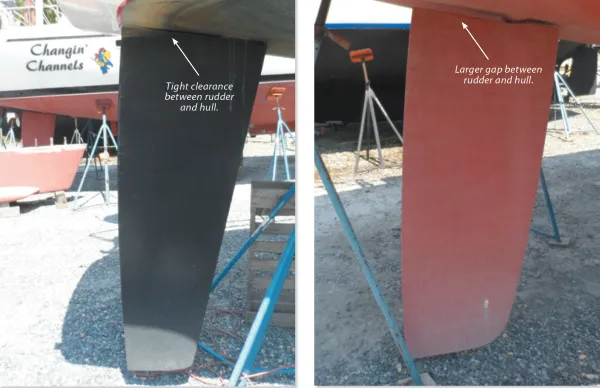
We’re cruisers not racers. We like sailing efficiently, but we’re more concerned with safety and good handling than squeezing out the last fraction of a knot. Heck, we’ve got a dinghy on davits, placemats under our dishes, and a print library on the shelf. So why worry about perfection below the waterline?
The reason is handling. A boat with poorly trimmed sails and a crudely finished rudder will miss tacks and roll like a drunkard downwind when the waves are up. On the other hand, a rudder that is properly tuned will agilely swing the boat through tacks even in rough weather, and provide secure steering that helps prevents broaching when things get rolly. The difference in maximum available turning force between a smooth, properly fitted rudder and the same rudder with a rough finish and poor fit can be as much as 50% in some circumstances, and those are circumstances when you need it the most. It’s not about speed, it’s about control.
It Must Be Smooth
Smooth is fast. That’s obvious. But it makes an even bigger difference with steering. Like sails, only half of rudder force comes from water deflected by the front side of the blade. The rest results from water being pulled around the backside as attached flow. How well that flow stays attached is related to the shape of the blade, which we can’t easily change, and to the surface finish of the blade, which we can.
Remember the school experiment, where you place a spoon in a stream of water and watched how the water would cling to the backside of the spoon? Now, try the experiment again as a grown-up, but with a different set of materials.
Try this with a piece of wood that is smooth and one that is very rough; the water will cling to the smooth surface at a greater angle than the rough surface. Try piece of smooth fiberglass or gelcoat; the water will cling even better because the surface is smoother. Try a silicone rubber spatula from the kitchen. Strangely, even though the surface is quite smooth, the water doesn’t cling well at all. We’ll come back to that.
Investigators have explored this in a practical way, dragging rudders through the water in long test tanks (US Navy) and behind powerboats.

If we are trying to climb to windward, it’s nice to get as much lift out of the rudder as practical, before drag becomes too great or before it begins to stall with normal steering adjustments. If the boat has an efficient keel and the leeway angle is only a few degrees, the rudder can beneficially operate at a 4-6 degree angle. The total angle of attack for the rudder will be less than 10 degrees, drag will be low, and pointing will benefit from the added lift. If the boat is a higher leeway design—shoal draft keels and cruising catamarans come to mind—then the rudder angle must stay relatively low to avoid the total angle (leeway + rudder angle) of the rudder from exceeding 10 degrees. That said, boats with truly inefficient keels but large rudders (catamarans have two—they both count if it is not a hull-flying design) can sometimes benefit from total angles slightly greater than 10 degrees—they need lift anywhere they can get it.
How can you monitor the rudder angle? If the boat is tiller steered, the tiller will be about 0.6 inches off center for every degree or rudder angle, for every 3 feet of tiller length. In other words, the 36-inch tiller should not be more than about 2 inches off the center line. If the boat is wheel steered, next time the boat is out of the water, measure the rudder angle with the wheel hard over. Count the number of turns of the wheel it takes to move the rudder from centered to rudder hard over, and measure the wheel diameter. Mark the top of the rim of the wheel when the boat is traveling straight, preferably coasting without current and no sails or engine to create leeway.
The rim of the wheel will move (diameter x 3.146 x number of turns)/(degrees rudder angle at hard over) for each degree of rudder angle. Keep this in the range of 2-6 degrees when hard on the wind, as appropriate to your boat. It will typically be on the order of 4-10 inches at the steering wheel rim. A ring of tape at 6 degrees can help.
How do we minimize rudder angle while maintaining a straight course? Trimming the jib in little tighter or letting the mainsheet or traveler out a little will reduce pressure on the rudder and reduce the angle. Some boats actually sail to weather faster and higher, and with better rudder angles, by lowering the traveler a few inches below the center line.
On the other hand, tightening the mainsheet and bringing the traveler up, even slightly above the center line on some boats, will increase the pressure and lift.
Much depends on the course, the sails set, the rig, the position of the keel, the wind, and the sea state. Ultimately, some combination of small adjustments should bring the rudder angle into the appropriate range. Too much rudder angle and you are just fighting yourself.
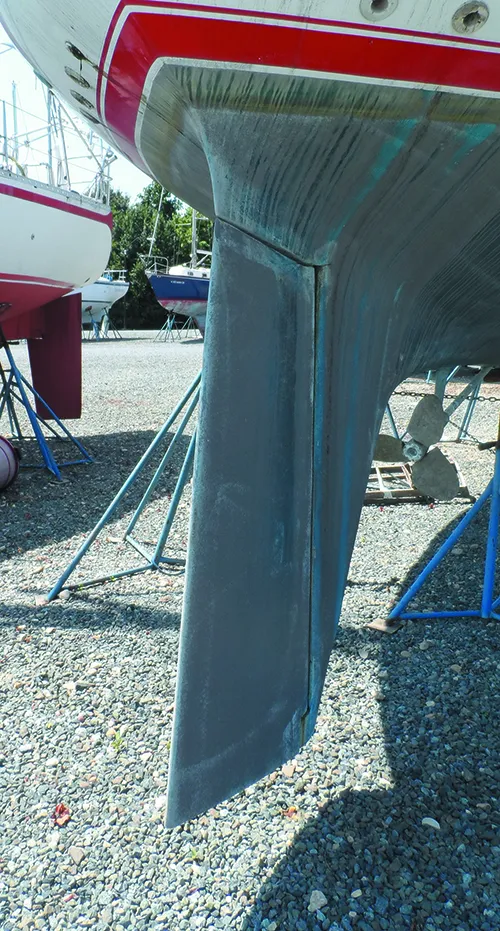
- Turn this rudder just 10 degrees and the end plate is lost, reducing the amount of lift generated.

- This rudder might as well be transom hung, the way that the end cap just disappears.
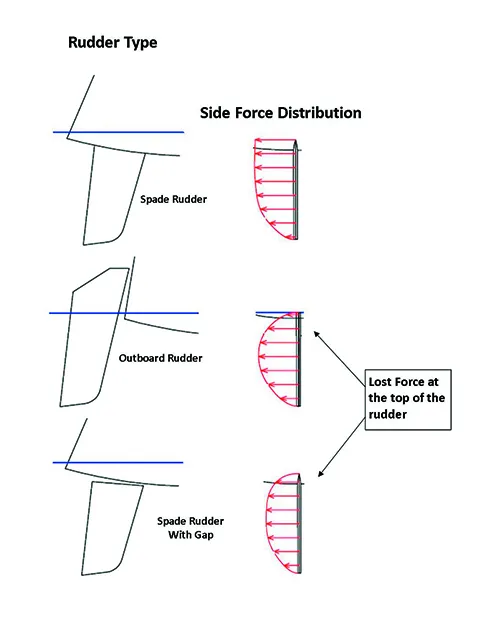
- Stern-hung rudders, and spade rudders with large gaps between the hull and the top of the rudder will lose their lift at the “tip” of the blade near the surface.
Surface roughness affects the lift from the rudder in two ways. A rougher surface has slightly lower lift through the entire range of angles, the result of a turbulent boundary layer instead of smooth flow over the entire surface. More dramatically, rougher blades stall at lower angles and stall more completely. The difference between a faired rudder with a polished finish and a rudder carrying a 10-year accumulation of rolled-on antifouling paint can be as much is 35 percent (see “Rudder Savvy to Boost Boat Performance,” above).
What can we do? If your rudder is a lift up type, don’t use bottom paint. Fair the blade within an inch of its life and lay on a gloss topside paint as smoothly as possible, sanding between coats. If you use a brush, stroke the brush parallel to the waterline, not along the length of the blade.
Which is faster, a gloss finish or one that has been dulled with 1000 grit sandpaper? Opinions go both ways, and we believe it may depend on the exact nature of the paint, which leads to the question, “Should we wax the blade?” The answer is a resounding, no.
Wax is a hydrophobic (readily beads water), like the silicone rubber spatula you tested, and as a result, water doesn’t always cling as well. Thus, whether the paint should be deglossed or not depends on the chemistry of the paint, but in all cases the final sanding should be 1000 grit or finer.
If the rudder stays in the water, antifouling paint is required. Sand the prior coat perfectly smooth. There should be no evidence of chips, runners, or any irregularity at all. Using a mohair roller, lay the paint on thin, and apply multiple coats to withstand the scrubbing you will give your rudder from time to time.
Even if you use soft paint on the rest of the boat, consider hard paint for the rudder. Sure, it will build up and you will have to sand it off periodically, but the rudder is small and no part of your boat is more critical to good handling. Take the time to maintain it as a perfect airfoil.
Close the Gap
Ever notice the little winglets on the tips of certain airplanes? As we know, those are intended to reduce losses off the tip of the wing. The alternatives are slightly longer wings or slightly lower efficiency. At the fuselage end of the wing, of course, there is no such loss because the fuselage serves as an end plate. The same is true with your rudder.
There’s not much you can do about losses from the tip; making the rudder longer will increase the chance of grounding and increase stress on the rudder, rudder shaft, and bearings. Designers have experimented with winglets, but they the catch weeds and the up-and-down motion of the transom makes them inefficient. However, we can improve the end plate effect of the hull by minimizing the gap between the hull and the rudder.
In principle it should be a close fit, but in practice the gap is most often wide enough to catch a rope. Just how much efficiency is lost by gap of a few inches? The answer is quite a lot. A gap of just an inch can reduce lift by as much as 10-20 percent, depending on the size and shape of the rudder and the speed. A gap of 1-2 mm is quite efficient, but normal flexing of the rudder shaft may lead to rubbing.
If the gap is tight, the slightest bend from impact with a submerged log can cause jamming and loss of steering, though in my experience once the impact is sufficient to bend the shaft, a small difference in clearance is unlikely to make much difference; the shaft will bend until the rudder strikes the hull. Just how tight is practical depends on the type of construction, fitting accuracy, and how conservative the designer was in their engineering.
Carbon shafts, tubular shafts, and rudders with skegs flex less, while solid shafts generally flex more, all things being equal. Normally a clearance of about 1/4-inch per foot of rudder cord is practical, and performance-oriented boats often aim for much less. If you can reach your fingers through, that’s way too much. Hopefully the hull is relatively flat above the rudder so that the gap does not increase too much with rudder angle.
Practical Sailor’s technical editor Drew Frye is the author of the books Keeping a Cruising Book for Peanuts and Rigging Modern Anchors. He blogs at his website, sail delmarva.blogspot.com .
RELATED ARTICLES MORE FROM AUTHOR
22 comments.
How happy to see good technical information about the science of boat speed and control. This information is valuable to everyone, but the “mainly just cruising” cohort usually doesn’t get enough in an easily understandable form. I always suggest some club level racing as the best way to learning how to sail, but many prospective racers have been put off from the sport or haven’t had good opportunities to join the fleets. Technical seminars are generally either too advanced for beginners to understand properly, and the beginner classes are frequently too basic to inspre those who would benefit from a deeper knowledge base in the science of sailing. Good on you, Practical Sailor, for your technical stories hitting the “sweet spot,” getting this information to those we’ll benefit most.
Great article. How about considering modifying a rudder to make it a hydrodynamically balanced rudder. I did it to my boat and the difference is outstanding. If I remember correctly 7% of the rudder area is forward of pivot center. It is a skeg hung rudder that now turns like it’s a spade rudder.
I’m “skeg hung” also. Would you be so kind as to posting a link or providing info as to you accomplished this feat. Thanks!
A very clear explanation of some quite complicated hydrodynamics – thank you! I am surprised by the US Navy results showing benefit of sanding further than 400 grit. Most other experimental data suggest there is negligible advantage in going beyond about 360 grit. Is the original reference publicly available? On Michael Cotton’s comment, a couple of points: Firstly, the amount of balance (i.e how far back you put the stock in the blade) has no impact on the hydrodynamic performance of a spade rudder. What it does do is change the feel of the rudder; a well balanced rudder will be easier to use, thereby probably allowing the steerer to sail the boat better. For a skeg rudder, the hydrodynamic impact of changing the balance depends very much on how the skeg/blade combination is configured. Secondly, 7% of rudder area forward of the stock is not enough for most rudders. The position of the centre of pressure is dependent on a lot of factors (aspect ratio, rudder angle etc.), but it is usually at least 15% back from the leading edge on a spade rudder, more often 20%. A balance somewhere between 10% and 15% is likely to give just enough feel without too much weight. However, rudder balance is still a bit of a black art, it really does depend on the rudder geometry.
the statement that one doesn’t want a silicone/silane coated ( super-smooth, hydrophobic: silicone-silane is just the example I am choosing, since it is now in use as a massively-speeding hull-coating, ttbomk ), as it *induces* flow-separation…
looks to me like conflating cavitation with flow-separation.
People have no problem teflon/ptfe-coating aviation-wings, as a means of *preventing* flow-separation.
the super-slick shape of a Cirrus’s composite wing, if made super-smooth/polished & super-slippery, “air-phobic”, as it were, *improves* its performance, not detracts from it….
Flow is always 1. laminar, then 2. turbulent, then 3. flow-separation.
unless the angle-of-attack ( AoA ) is small-enough to prevent separation.
The Gentry Tufts System, for *seeing* when a separation-bubble begins, on a sail, is brilliant ( Arvel Gentry was a fluid dynamicist, & realized that once one has a *series* of tufts, from luff on back, about 1/4 up the luff, one can *see* the beginning of a flow-separation-bubble, & tune the sail to keep it *just*-beginning, because *that* is MAX lift. Wayback Machine has his site archived, btw )
The aircraft designer Jan Roskam wrote of a DC-10 crashing because pebbled-ice as thick as the grit on 40-grit sandpaper had formed on the upper wings…
obviously, engineered to require laminar, there, but having turbulent, cost all those lives.
iirc, it was Arvel Gentry, or “Principles of Yacht Design”, that stated it takes a ridge of about 0.1mm, only, to trip the flow around a mast from laminar to turbulent…
Given how barnacles & such are generally 100x or more as thick as that, when removed from a hull, I think laminar-flow is something that exists only for the 1st day or so after launching!
I now want to see experiment showing polar curves for rudders coated normally, uncoated, & ailicone-silane coated, to see if it is the coating that induces separation-bubbles, or if it is AoA exceeding functional angle, for that surface & foil,, while the boundary-layer is in specifically turbulent flow, as opposed to the ideal laminar, as aviation’s results indicate…
just an amateur student of naval-architecture & aircraft-design ( Daniel P. Raymer’s “Conceptual Aircraft Design” is *brilliant*, btw ), who happens to study this stuff autistically, as that is the only way to make my designs become absolutely-competent, is all…
I got a pearson and the rudder broke. Can I just replace with a outboard rudder mount it off set for room for outboard need info.
You could but it will not work very well. How badly it would perform is difficult to say. It might be just poor or disastrous. Things really need to be balanced on sail boats.
Polished rudders stall at low angles of attack and ask any hobie cat racer.
Pi is NOT 3.146
3.1416 maybe
Yup, 3.1416. Typo.
Before 2005 , when I fully retired and went cruising 10 months per year, I changed auto pilots, the hydraulics of which reduced the maximum rudder angle. “Someday” had always been difficult to steer in marinas, so I added 30% more rudder area to the Gulfstar 41′ by deepening and following the existing angles. (the pivot was unchanged, as all added area was aft of that.) It increased rudder effort noticeably, but not excessively, improved motor maneauvering and allowed being able to hold a close line better. Noticeably, it caused a lot more stalling of the rudder whenever it was turned very much. A recent tangle with a Guatemala fish net damaged the extension, which I had intended to be sacrificial. I cleaned up the separation somewhat, but have not replaced the extension. The boat again now requires more steering correction when heading at all upwind, but the rudder does not stall as easily.
This is not a scientific study, just my personal non-scientific observations. The added rudder area was quite low, and the fairing quality was…well! modest.
I’ve seen data suggesting ~ 400 grit is best, and I’ve seen data suggesting polished is best. They were both smart, respected guys that I would not second guess. My conclusion is that other factors, such as the specific foil profile and the type of coating, are involved. Let’s just agree that many layers of rolled bottom paint with a few lumps and chips is sub-optimal! We’re talking about cruising boats.
Thanks for great article. I’m convinced enough to go sand my bottom paint off the lifting rudder of my Dragonfly Tri.
Absolutely! No lifting rudder should have bottom paint. My Farrier rudder was sanded fair and painted with gloss white.
Dagger boards and center boards that retract still need antifouling, since they do not lift clear of the water, but because they are in a confined space with little oxygen or water flow, fouling is very limited. Because the space is tight and paint build-up can cause jamming, sand well and limit the number of coats. For my center board I go with two coats on the leading edge (exposed even when lifted) and one coat on the rest.
I do remember a comment directed to cruisers a few years back suggesting that a faster cruiser would be more likely to get out of the way of dirty weather, especially with modern forecasting. I reckoned that this concept would gain traction, but I haven’t seen it. Can anyone weigh in on this opinion?
I would agree ONLY for coastal crusing when a safe harbor is always no more than a day away. OR ocean racing where speed matters and the boat is kept light. We all know weather reports past 24hours are a guide not a guarantee. Once a storm is bearing down NO boat even a fast one is going it out run a storm. Also we sail on boats that need wind and it’s always a balance between a course between high pressure systems (doldrums) and low pressure systems (high likelyhood of a storm) so because we seek wind sometimes we get more then we want. Try and avoid that and you risk venturing too far into the high pressure system and NO wind. So yes weather forecasts can give you a 1-2 day weather window and a fast boat that can get the hell out of dodge and put a few miles between itself and the oncoming weather could avoid a storm. BUT we are usually not talking about a world ocean race boat vs an old full keel tank. We are talking a faster but still rather slow loaded down cruising boat. It may be only the difference of 7knot average vs 9 knots average. Even a faster cruiser/racer is not a stripped down Volvo series racer. And even those super fast ocean racers pushing the edge of technology get caught in storms and frankly I would not want to use one of those boats as my floating home on the water. They are a thrilling ride but far from comfortable. And they STILL can’t sail fast enough to out run a storm and guarantee you you will never have to sail in big waves and high winds. There is not a cruising SAIL boat that is as fast as a center console fishing boat with 1200hp in outboards on the back and guess what when a squall is coming even they get caught and can’t out run it. And no it’s not a hurricane and it won’t last long but it’s enough when it hits you if your on a light boat over canvased because trying to outrun the oncoming squall it’s enough to get scary. And then there is comfort. Even when there is no storm near you the swell from a storm hundreds of miles away can make for a uncomfortable ride in a boat designed to go fast vs a heavy displacement boat that just pushes threw waves and Has the tonnage not to get knock around. So much of this article screams weekend coastal sailing as even a week on anchor all that work to smooth your rudder will be canceled out by bottom growth todays antifoul paints don’t work as good as the older but far more toxic formulas so even the most meticulously cleaned cruising boat picks up growth ya you can dive and clean it regularly but I often it’s like Sisyphus pushing that rock up the hill. And besides if your sailing on a fullkeel with a keel hung rudder most of this is mute. yes a clean smooth bottom makes a difference on any boat but it’s the full keel and its tendency to track straight the over all weight and momentom of the boat it’s not fast and never will be but they can maintain their hull speed and track a comfortable ride threw chop and be unaffected by the swell. I’ll take a old full keel boat with a protected rudder I know is very unlikely to ever hit something to bend it or loose my rudder ever over a spade rudder or even worse duel rudders both hung exposed with a long but thin bolted on keel that if you hit a coral head means a haul out to inspect it as it more then likely cause a lot of expensive damage. And if not fixed right could lead to a future disaster (Cheeki Rafiki).
As interesting as the article reads, I wonder how it helps a prospective buyer of a used boat. Pictures will not do, and neither will taking several boats out of the water to examine them; it’s too expensive. It would be more helpful to indicate which boat manufacturers have the type of rudder the author recommends. After all, the buyer usually cannot be expected to change a rudder prior to buying it; it is also expensive. By the way, these types of very sophisticated articles are seen when it comes to hulls, keels, or rigging but without identifying the boats that carry the wrong equipment. If a specific rudder or keel configuration is not the proper one for efficient sailing, the author ought to state which boats carry the proper ones so that the buyer will concentrate on the whole (the boat) rather than the part.
I was describing the opportunity to improve the existing rudder. As I think back, I have modified the rudder of every boat I have owned in order to improve efficiency. The first two got small changes in balance and improved trailing edge sharpness. On the third I tightened the the hull clearance and changed the section. On my current boat I adding an anti-ventilation fence to improve high speed handling. https://4.bp.blogspot.com/-2ZGPzKdj_tE/WyF9G2mHtLI/AAAAAAAAOwE/r6zgQEr4vkcDB4ciMLcgboFdazDAseDBgCLcBGAs/s1600/ian%2Brudder%2Bfence.jpg None of these tasks was overly difficult, and none was undertaken until I had sailed the boat for a season and learned what balance she liked and noted her habits.
For me, I buy a boat based on reputation, a test sail, and in most cases, a survey. As you imply, it is the whole boat you are buying. Does it have good bones? Do you feel happy at the helm? Then comes the fine tuning. I’ve been told that I sell a boat when I run out of things to tweak.
wow, so now case reports/medical reports/evidence don’t count as “evidence”, but certain remedies, even if they are cited in medical journals but do not work in the real world, count as evidence to you?? Maybe we need to redefine evidence based on your philosophies.Anyway, i’ve wasted enough time here. goodbye.
Weight 2.5 tonnes
Do you have any articles on the ideal cross section shape for an outboard rudder mounted 50mm from the transom vertically The yacht is a 26 ft trailer sailer weight 2.5 tonnes
The most common choice would be NACA 0012. http://airfoiltools.com/airfoil/details?airfoil=n0012-il
There are many ways to build a rudder, including laminated solid rot-resistant wood and fiber glass covered foam with a metal armature core. For the DIY, laminated wood is probably the most practical.
LEAVE A REPLY Cancel reply
Log in to leave a comment
Latest Videos
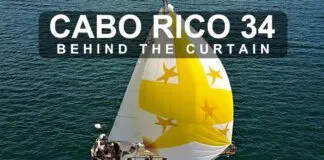
Cabo Rico 34 Boat Review

Super Shallow Draft Sailboat: The Leeboard Sharpie

Hans Christian 41T – Boat Review

Seven dead after superyacht sinks off Sicily. Was the crew at...
Latest sailboat review.
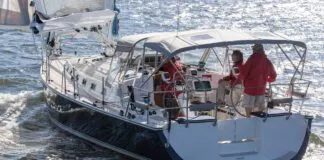
- Privacy Policy
- Do Not Sell My Personal Information
- Online Account Activation
- Privacy Manager
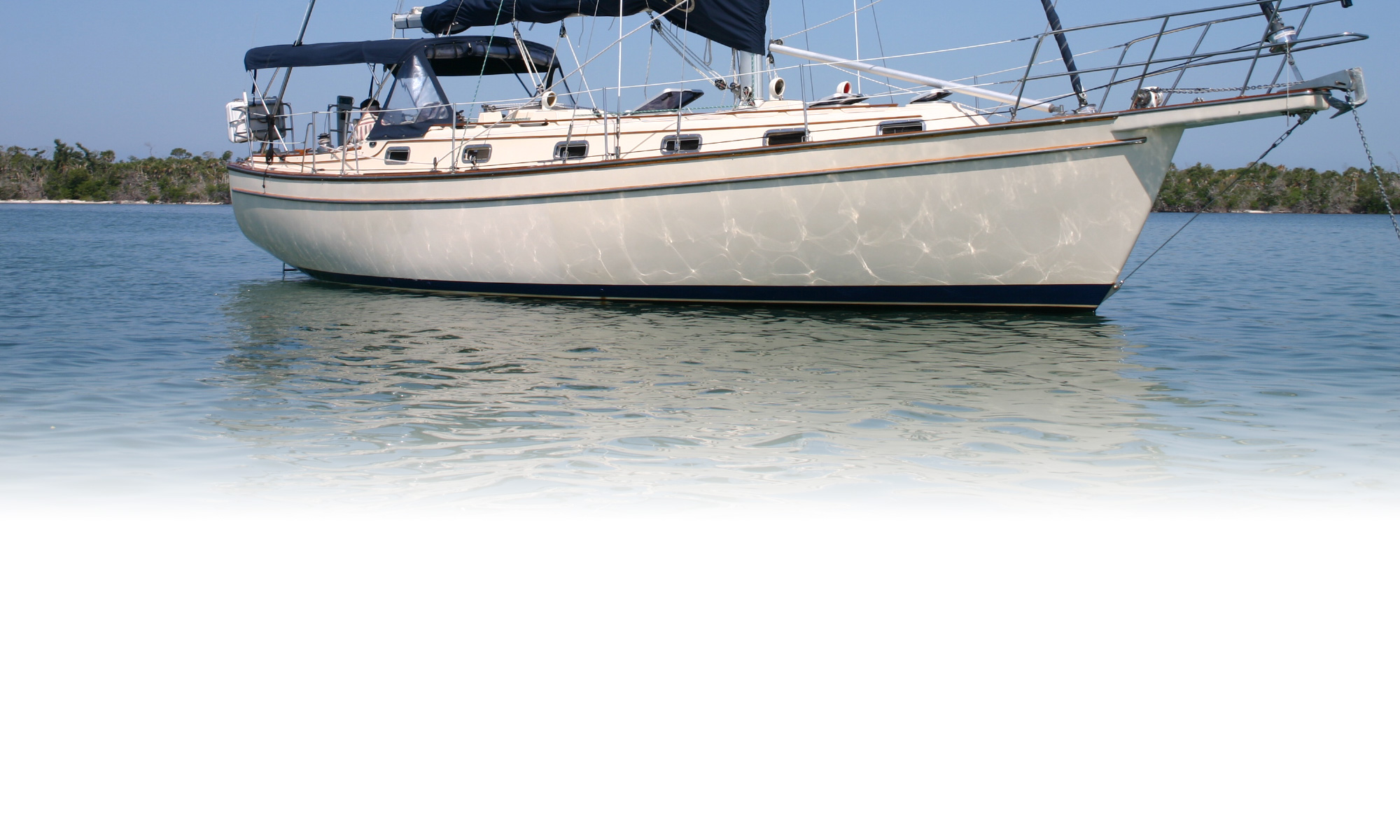
New Rudders
Replacement Sailboat Rudders and Centerboards
NEW!! Tanzer Rudders now available. See info under the News Tab.

Foss Foam Products of Florida, Inc. is the world’s leading producer of sailboat rudders, having manufactured over 50,000 rudders since 1978. As a family-owned company, Foss Foam has been an Original Equipment Manufacturer (OEM) for numerous sailboat companies for over 46 years. This long-standing expertise enables us to produce a wide range of replacement rudders as well as rudders for new sailboats. With over 300 molds from dozens of manufacturers in our inventory, we also have the capability to create molds for models we do not currently have.

Foss Foam Products of Florida, Inc.: A Legacy in Foam Manufacturing
In the 1960s, Chuck Foss began formulating and producing foam products in Costa Mesa, California, starting with surfboard blanks. He then developed a twenty-pound-per-cubic-foot density foam ideally suited for rudder fabrication. Under the name The Foss Company, Chuck Foss built most of the rudders for manufacturers in the western United States.
In 1978, Bob Walker and his wife, Maxine, founded Foss Foam in Clearwater, Florida. They started the business without any guaranteed customers, but quickly began producing rudders for most sailboat manufacturers in the Eastern U.S. Over the years, Foss Foam Products of Florida, Inc. has become the world’s leading producer of rudders.
In 1987, Bob and Maxine’s son, Al Walker, joined the family business, allowing his parents to retire in 1994. In 2000, the Walker family relocated the business to Williston, Florida, in the North Central Region, about 25 miles west of Ocala and Gainesville. Since the move, Foss Foam has experienced steady growth.
Al Walker has since been joined by his son, David, who now leads production and quality control. David has made significant contributions to the growth and stability of Foss Foam Products of Florida, Inc. As the heir apparent, he will ensure that Foss Foam continues to lead the sailboat rudder manufacturing industry in the future. Our commitment to quality and expertise remains unmatched. While many companies cut corners to maximize profits, we are dedicated to producing the best rudders money can buy.
Call today to learn how we can help you get back on the water. 352-529-1104

World Class Rudders, Tillers, and other Gear for Real Life Sailing
Sailboat rudders, sailboat tillers, custom rudders/ tillers, sailboat accessories, rudder repair worksheet, instructional handbook, looking for a product for your sailboat.
Can't Find your Sailboat?
Why Rudder Craft?
At Rudder Craft we build every sailboat rudder with the singular focus of improving your sailboat’s steering performance. In order to accomplish this our sailboat rudders incorporate a hydrofoil design, as a matter of course. Sailboats ranging from the West Wight Potter 15, all the way up to the MacGregor 36 and Catalina 42, will find a more accurate helm once a Rudder Craft hydrofoil sailboat rudder is installed.
Why Hydrofoil?
Operating on principles similar to airplane wings, the foiled sailboat rudder design generates lift as the sailboat makes way. By employing the sailboat rudder to reduce drag, and increasing the force the sailboat rudder is able to exert, any sailboat will find themselves performing better: weather helm is reduced, tacking is crisper, points of sail are easier to keep, and helm effort is greatly reduced in light and moderate air.
Why Use a Kick-up Rudder?
Subscribe to our blog.
Join our mailing list to receive the latest news and updates from our team.
You have Successfully Subscribed!
No results found.
The page you requested could not be found. Try refining your search, or use the navigation above to locate the post.
Blog Coming Soon!
Customer reviews.

Red Ant Radio Yachts
Producing championship winning boats that are light, strong and competitive
Electronics

Red Ant’s new sail winches and high voltage rudder servos are the latest addition to the Red Ant range of components and complete kits.
Sail winches
After months of testing in racing conditions, we’re excited to launch our new Stinger winch that’s shown to be precise, smooth and fast. It’s also a direct mount replacement for the RMG, which can be difficult to source.
Find out more
Rudder servos
Our new range of high voltage servos includes a standard version and a lighter version that can save you 20grams. Both can take a 7.4volt battery, have more torque, are more responsive and allow for more precise centring.
We recommend buying the 7.4volt servo when you buy a Red Ant winch.
Winch drums

Our new range of winch drums includes a 26mm single and double, and 32mm single or double variation, making them suitable for most requirements.

- Copy shortlink
- Report this content
- Manage subscriptions

- Sailboat Equipment
- Sailboat Steering
Pintles & Gudgeons

ILCA Laser Gudgeon

Allen Brothers Pintle For A 7000

Allen Brothers 6MM Stainless Steel Optimist Transom Gudgeon

Allen Brothers 6MM Stainless Steel Short Optimist Rudder Pintle
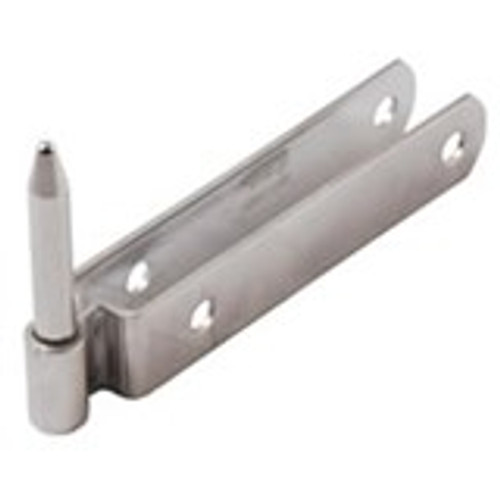
Allen Brothers 6MM Stainless Steel Long Optimist Rudder Pintle
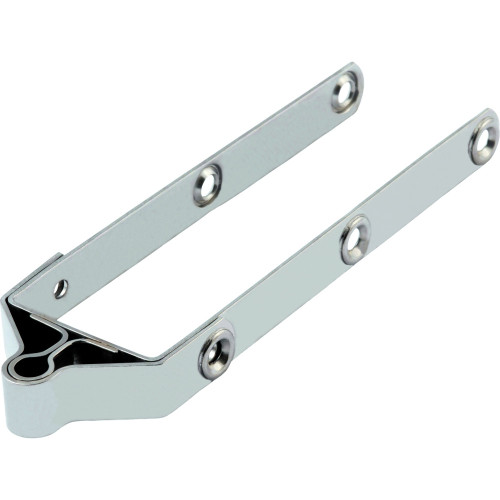
Allen Brothers 8mm X 43mm Stainless Steel Rudder Gudgeon
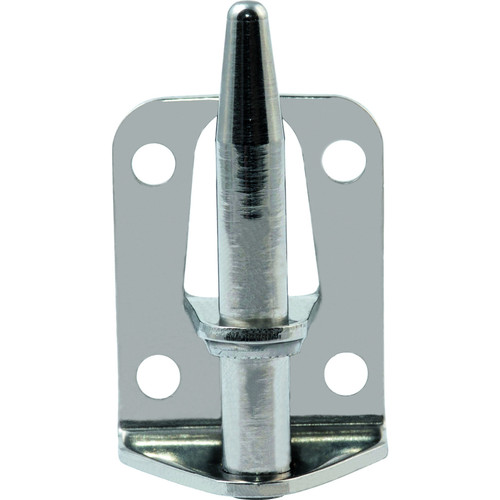
Allen Brothers 7.8mm Stainless Steel Transom Gudgeon

Allen Brothers 8MM Stainless Steel Transom Gudgeon

Allen Brothers 8MM X 11MM Short Rudder Pintle

Allen Brothers 8MM X 11MM Long Rudder Pintle

Allen Brothers 8mm X 38mm Stainless Steel Rudder Gudgeon 120mm

Allen Brothers 8MM Stainless Steel H/D Transom Gudgeon

Allen Brothers 8mm Pin Hole Stainless Steel Transom Gudgeon

Allen Brothers 8MM Stainless Steel H/D Transom Pintle

Allen Brothers 8MM Stainless Steel Transom Pintle

Allen Brothers 8mm X 38mm Stainless Steel Rudder Gudgeon 92mm

Allen Brothers 8MM X 54MM Stainless Steel Rudder Gudgeon

Allen Brothers 8MM X 51MM Stainless Steel Rudder Gudgeon

Allen Brothers 8MM X 45MM Stainless Steel Rudder Gudgeon
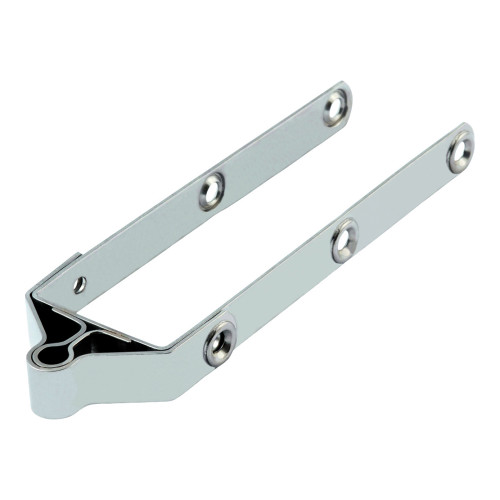
Allen Brothers 8MM X 42MM Stainless Steel Rudder Gudgeon

- Forums New posts Unanswered threads Register Top Posts Email
- What's new New posts New Posts (legacy) Latest activity New media
- Media New media New comments
- Boat Info Downloads Weekly Quiz Topic FAQ 10000boatnames.com
- Classifieds Sell Your Boat Used Gear for Sale
- Parts General Marine Parts Hunter Beneteau Catalina MacGregor Oday
- Help Terms of Use Monday Mail Subscribe Monday Mail Unsubscribe
Best wood for rudder
- Thread starter Phyrexii
- Start date May 25, 2013
- Forums for All Owners
- Ask All Sailors
Clear cedar or mahogany if you want to spend money. Oak is not very rot resistant. Don't leave it in the water either way.
Old Skool Neil
If you're a metals guy why not make a hollow stainless rudder? That's what Fleming does on their pendulum steering vanes as well as their auxiliary rudder variation for center cockpit boats.
Old Skool Neil said: If you're a metals guy why not make a hollow stainless rudder? That's what Fleming does on their pendulum steering vanes as well as their auxiliary rudder variation for center cockpit boats. Click to expand
I used this site for my rudder redux. http://www.jamestowndistributors.co...em/Rudder_Blades_and_Centerboards_000_448.pdf Here is another....... http://www.jamestowndistributors.co...do?docId=814&title=Building+a+Sailboat+Rudder
Carefully select pressure treated southern yellow pine. Resaw it and dress it to the thickness that you want and laminate it with PL premium construction urethane adhesive.
Merlin Clark
Fir is light, strong, rot resistant, not pricey and readily available.
What variety of fir?
I think it's Douglas fir Ross. Kinda of rare down here, I buy from a yard in Cape Canaveral that used to supply long line, shrimp and scallop boats before they got chased out to make room for cruise ships and tourists.
Doug Fir would be a good choice if he can find any high ring count pieces. Most of it is plantation grown and often less than ten rings to the inch. must avoid the pith and of course all sap wood.
The stock rudder for our boat was mahogany. Our rudder is 35 years now and has suffered prop bites, edge damage and other indignities, but it is still straight, no splits. When we bought the boat i immediately filled the dings and refinished it and it's been watertight and smooth for 6 seasons. I'm currently touching it up. But it would be an expensive piece of wood today, i bet. If I had to make a rudder from scratch tomorrow, and it was to have a NACA profile, I would use either marine ply, or synthetic core . Maybe foam with stringers covered with a strong fiberglass skin, like how they make surfboards. How will you be shaping the rudder to the profile?
Kenn, I have a 30 x 60 CNC milling machine at my disposal, and I am a professional CNC programmer / machinist. It is an easy thing for me to toss a blank on the machine and 3D mill the shape. I estimate it will take about an hour or so of cutting to do both sides. I have an original mahogany rudder, but it's not 'kick up', and it didn't come with any fittings when I bought my boat. So, rather than cut it up, I took a regular 2 x 12, and quickly made a rudder - and it works fairly well. But now I want to make one that works well and looks nice, and I want to incorporate some of the design features I want internally (I want to add the ballast weight internally, I want a NACA shape for performance, I want internally routed lines or some other kind of mechanism for raising / lowering / releasing upon impact). (see http://forums.macgregor.sailboatowners.com/showthread.php?p=884816#post884816 for my current setup - ugly, but functional)
Dave Groshong
For $869 we offer an upgrade, a true air foil shape, lifetime warranty on the blade, includes a beautiful laminated tiller and ready to go sailing right out of the box: http://shop.macgregorowners.com/detail-rudders.htm?step=2&xkw=Macgregor&skipred=T If you really want to build your own, I recommend fir, or any decent vertical grained wood, finished with epoxy and paint.
Attachments

- This site uses cookies to help personalise content, tailor your experience and to keep you logged in if you register. By continuing to use this site, you are consenting to our use of cookies. Accept Learn more…

IMAGES
VIDEO
COMMENTS
There are several different types of rudders in common use. Sailboats use full keel rudders, spade rudders, outboard rudders, and skeg-mounted rudders, plus variations on each type. What type of rudder is best depends on the shape of the hull and the boat's size.
Modern ship rudder (the long red rectangle behind the propeller) RMS Olympic's rudder turned. A rudder is a primary control surface used to steer a ship, boat, submarine, hovercraft, airship, or other vehicle that moves through a fluid medium (usually air or water).On an airplane, the rudder is used primarily to counter adverse yaw and p-factor and is not the primary control used to turn the ...
The four rudder types are: full, spade, skeg, and outboard. This article discusses the advantages and disadvantages of each. The full or full keel rudder lies at the aft end of a full length keel. The keel-rudder streches along the entire length of the bottom of the hull. The full rudder is safe and nearly invulnerable to damage.
A sailboat rudder works by changing the direction of the water flow past the boat's hull, which in turn changes the direction of the boat. The rudder is attached to the stern of the boat and can be turned left or right. When the rudder is turned, it creates a force that pushes the stern in the opposite direction and turns the bow towards the ...
Components and mechanics of boat rudders. A typical boat rudder consists of several key components: Rudder blade: The rudder blade is the flat, vertical surface responsible for redirecting the water flow. It is the most critical part of the rudder and comes in various shapes and sizes. Rudder stock: The rudder stock is a sturdy vertical shaft ...
After hull integrity, rudder integrity is the most vital component of a seaworthy vessel, yet most sailors pay more attention to LED lighting or smartphone apps than they do to their boat's rudder. Before you shrug off rudder failure as a remote concern, consider that the incidence of mid-ocean rudder failures is close to 1 percent.
A sailboat is steered by means of the rudder, a flat vertical surface beneath the water near the stern. Different rudders have different advantages. ... Tom Lochhaas is an experienced sailor who has developed several boating safety books with the American Red Cross and the U.S. Coast Guard Auxiliary. Learn about our Editorial Process. Updated ...
Obviously, the rudder is a pretty important part of a sailboat. Without it, the boat cannot counter the forces put into the sails and cannot steer in a straight line. It also cannot control its direction, even under power. A rudder failure of any kind is a serious emergency at sea.
A sailboat rudder steers the boat. A rudder is a hinged fin or blade mounted on the stern of the vessel that turns side to side, and it's controlled by a tiller or a helm. A rudder is one of the primary controls of a sailboat. When the boat moves forward through the water, the rudder causes friction on one side and changes the direction of the ...
A sailboat rudder is a flat plate or blade attached to a boat's stern, used to control the boat's direction and enhance its stability and performance. The rudder's design has evolved over time, and modern advances in materials and technology have led to further improvements in its function and efficiency.
1. Shares. 1. The rudder evolved from a steering board that was used in ancient times. The steering board was usually mounted on the right-hand side to suit right-handed sailors. With the advancement of technology and enhancement in ships' designs, the steering board moved onto the centre line through a stock passing through the vessel.
You can bond control lines for centerboards and rudders-in-place by wetting a slightly oversized hole (about 1.5″ to 2″ deep) with epoxy/404 High-Density filler mixture. It helps to mark the hole's depth on the rope with vinyl electricians tape to serve as a guide.
Glass one side of the rudder, let cure. Cut off excess edge stuff and rough sand/grind. Glass other side of rudder, let cure. Cut off excess, sand until flush. Glass edges based upon which were generally 'up' when clamped in a mostly horizontal way (images 4 and 5). Glass the remaining edges.
Turn this rudder just 10 degrees and the end plate is lost, reducing the amount of lift generated. This rudder might as well be transom hung, the way that the end cap just disappears. Stern-hung rudders, and spade rudders with large gaps between the hull and the top of the rudder will lose their lift at the "tip" of the blade near the surface.
See info under the News Tab. Foss Foam Products of Florida, Inc. is the world's leading producer of sailboat rudders, having manufactured over 50,000 rudders since 1978. As a family-owned company, Foss Foam has been an Original Equipment Manufacturer (OEM) for numerous sailboat companies for over 46 years. This long-standing expertise enables ...
Sailboat Rudder Pintles: These pins are mounted on the rudder and fit into the gudgeon holes, allowing the rudder to pivot smoothly. Sailboat Rudder Gudgeons: These components with holes are mounted on the transom, receiving the pintle pins for rudder movement. Sailboat Tillers. Tiller Extensions: Extend the reach of your tiller for better ...
Why Rudder Craft? At Rudder Craft we build every sailboat rudder with the singular focus of improving your sailboat's steering performance. In order to accomplish this our sailboat rudders incorporate a hydrofoil design, as a matter of course. Sailboats ranging from the West Wight Potter 15, all the way up to the MacGregor 36 and Catalina 42 ...
Red Ant's new sail winches and high voltage rudder servos are the latest addition to the Red Ant range of components and complete kits. ... Red Ant's Stinger winch in action Rudder servos. Our new range of high voltage servos includes a standard version and a lighter version that can save you 20grams. Both can take a 7.4volt battery, have ...
RED JACKET 17. Save to Favorites . Beta Marine. BOTH. US IMPERIAL. METRIC. Sailboat Specifications Definitions Hull Type: Fin w/transom hung rudder: Rigging Type: Fractional Sloop: LOA: 17.26 ft / 5.26 m ... Like the LWL, it will vary with the weights of fuel, water, stores and equipment. A boat's actual draft is usually somewhat more than ...
Devoti Sailing. Dripper Guard. Dynamic Dollies. Dynamic/Seitech Dollies Compatible Parts. Type 1: Boats up to 250 lbs Dollies. Type 2: Laser, Byte & Invitation Dollies. Type 3: Curled Gunwale Boats Dollies. Type 4.1: Small/Med Bowsprit Boats Dollies.
Sep 4, 2010. 115. MacGregor Venture 25 Ocean Grove, Swansea MA. May 25, 2013. #1. I'm currently working on a design for a transom hung kick up rudder for a 25' boat (specifically a Venture 25). Nominal dimensions are 1 1/2 x 12, with 4' below the waterline, with a true NACA profile. I'm planning on laminating two pieces of 1 x 12 wood together.
RED ADMIRAL 36. Save to Favorites . Beta Marine. BOTH. US IMPERIAL. METRIC. Sailboat Specifications Definitions Hull Type: Fin with rudder on skeg: Rigging Type: Fractional Sloop: LOA: 36.18 ft / 11.03 m ... Like the LWL, it will vary with the weights of fuel, water, stores and equipment. A boat's actual draft is usually somewhat more than ...
The way I've got the blades drawn, I'm wondering if the rudder needs a little more submerged surface area (right now it's 16.5" deep and a little less than 8" at the waterline). Because the sail is pretty far forward and relatively small, the CE stays forward and the CLR (marked with a red point behind the daggerboard) seems to be in a good place.